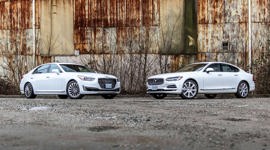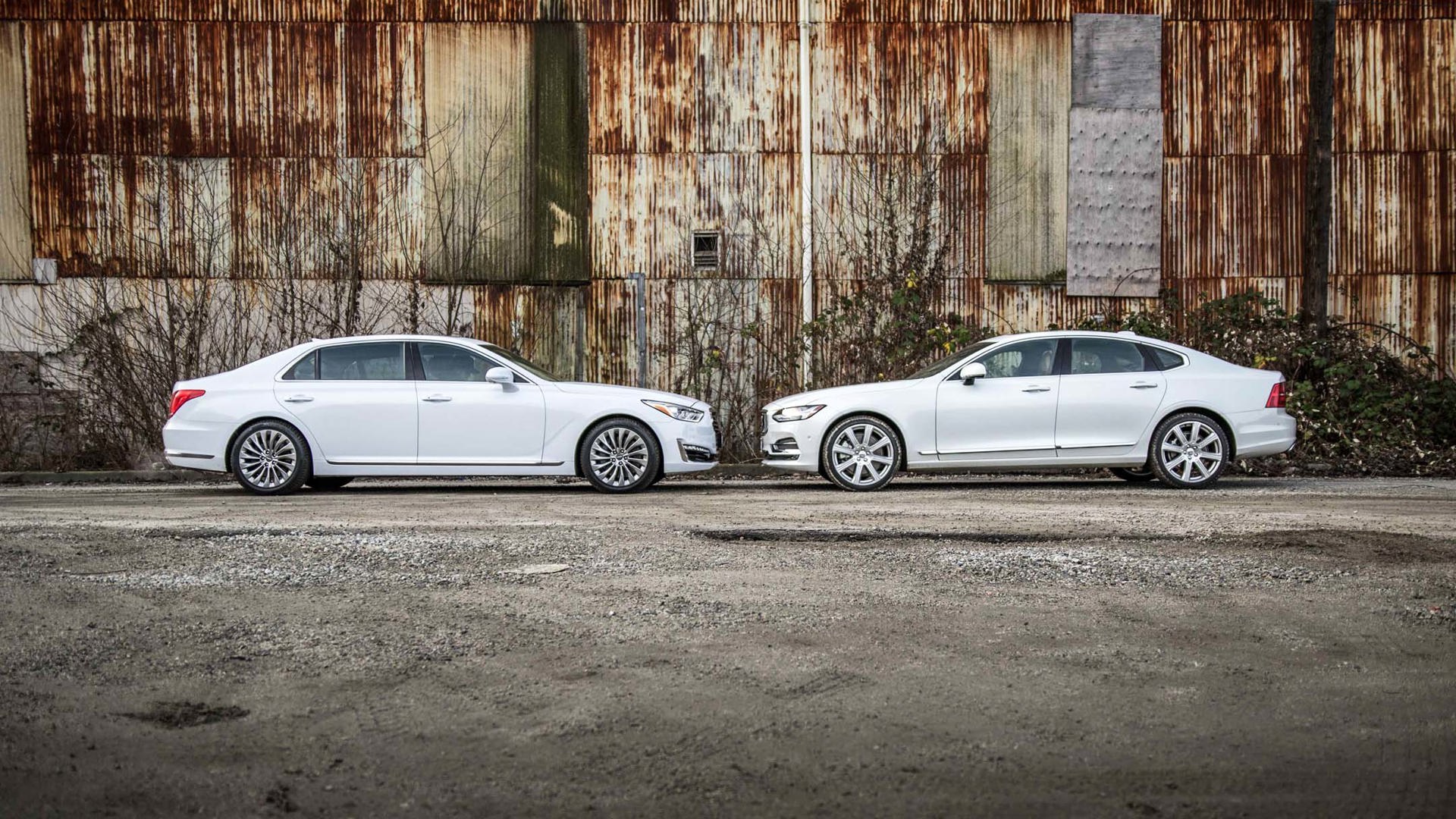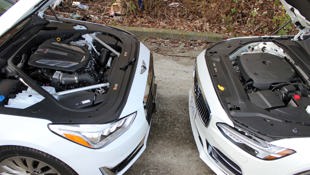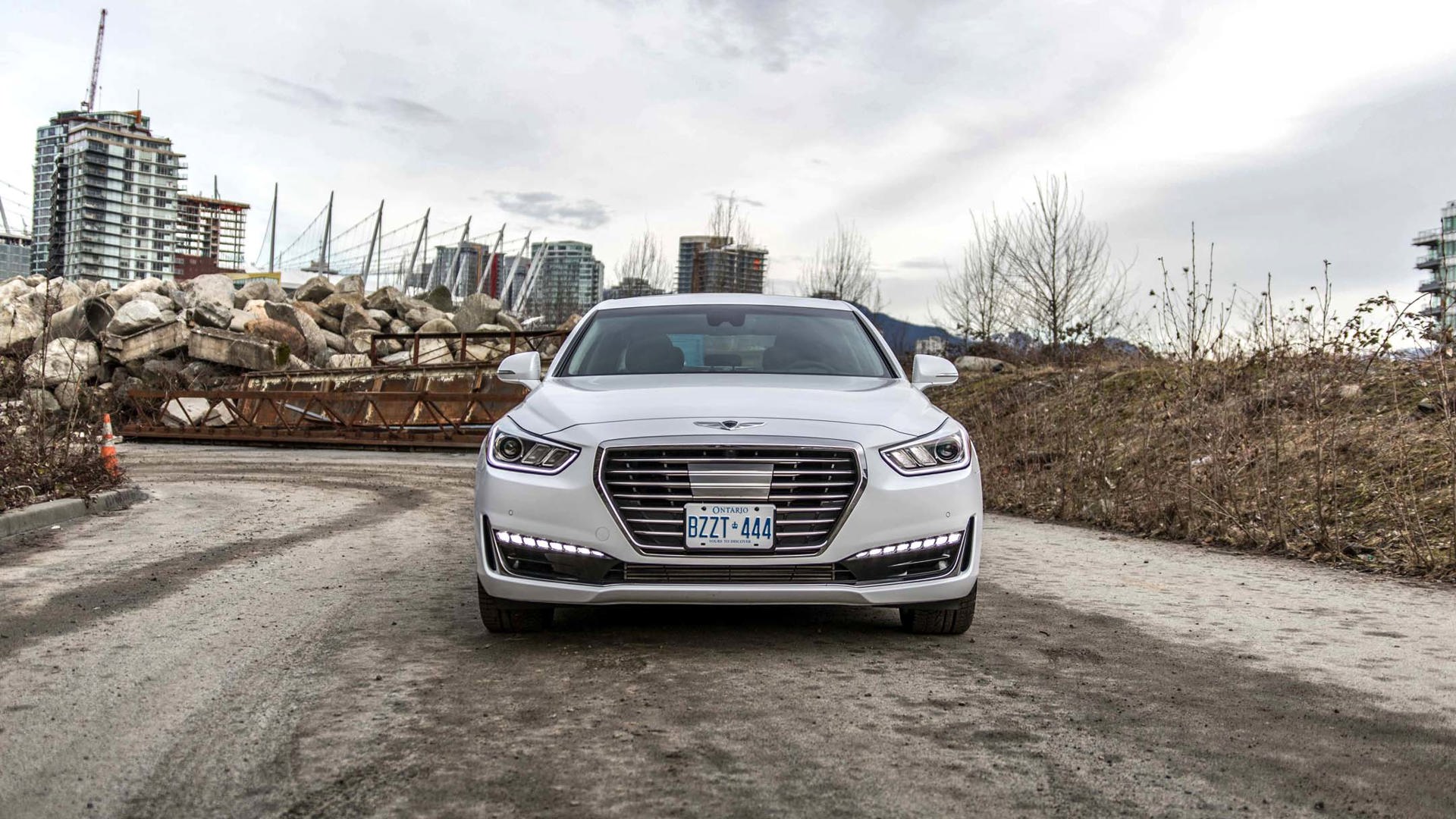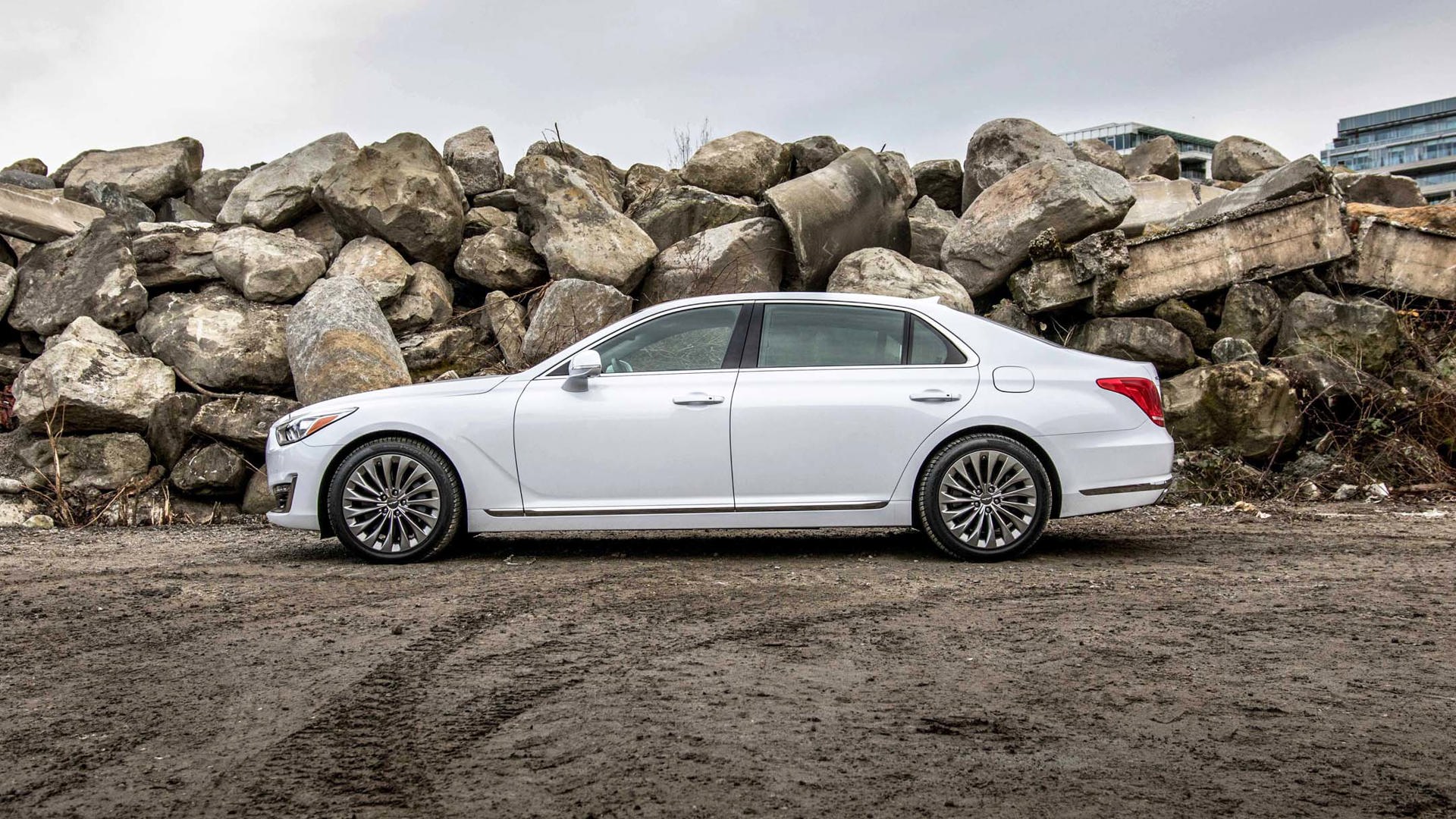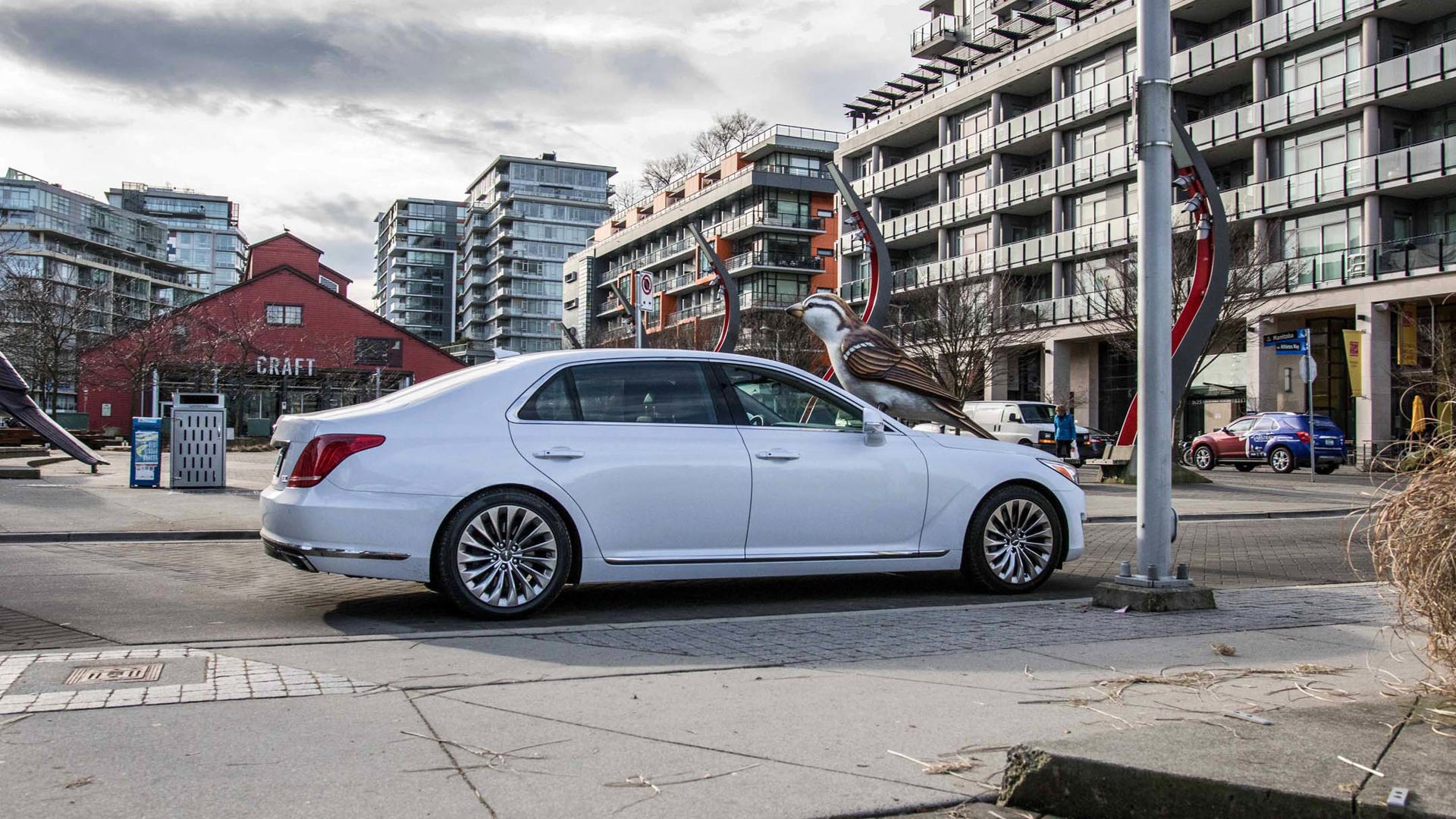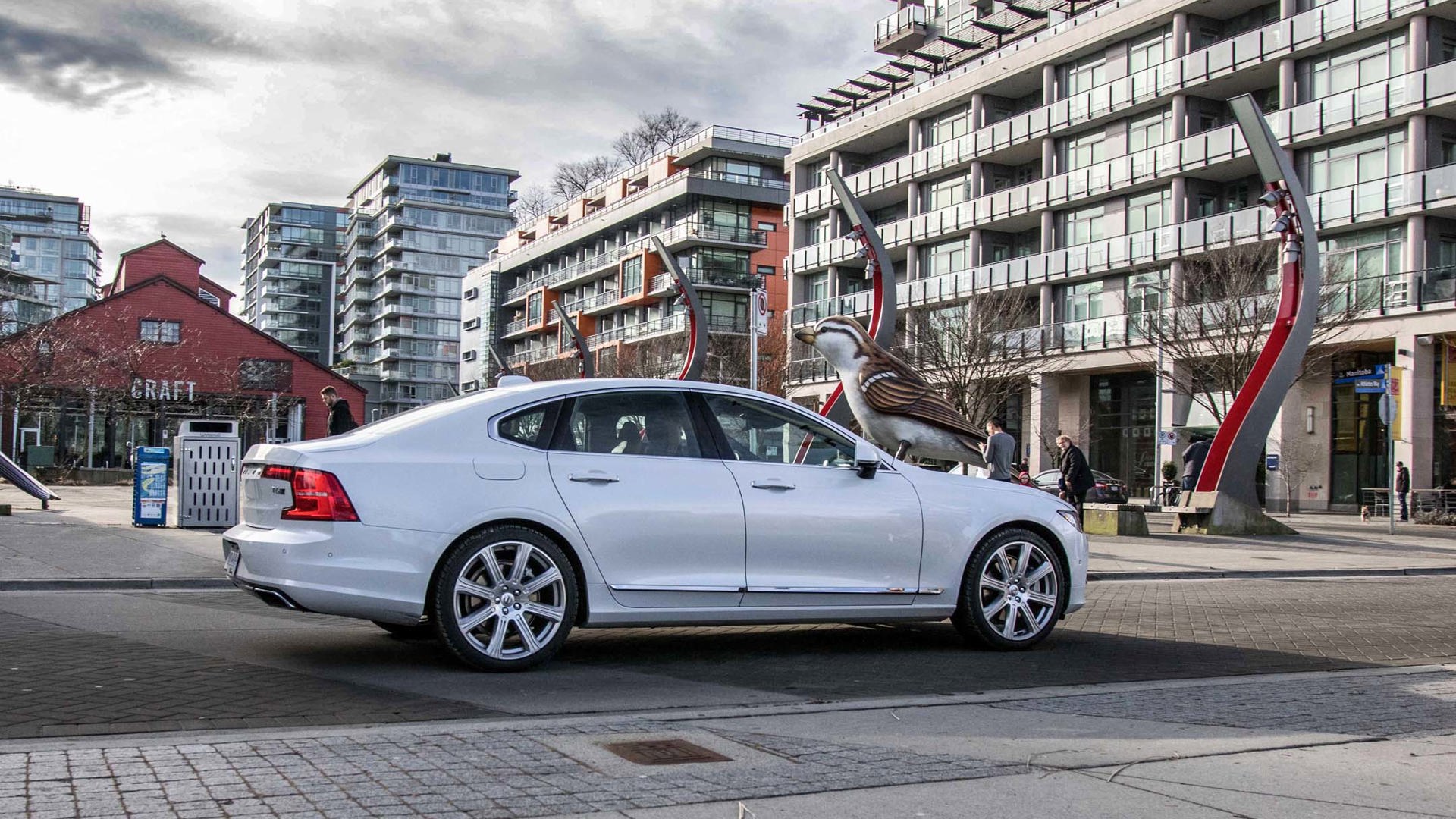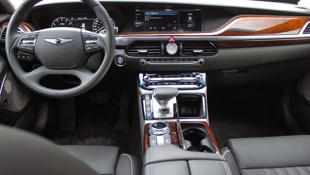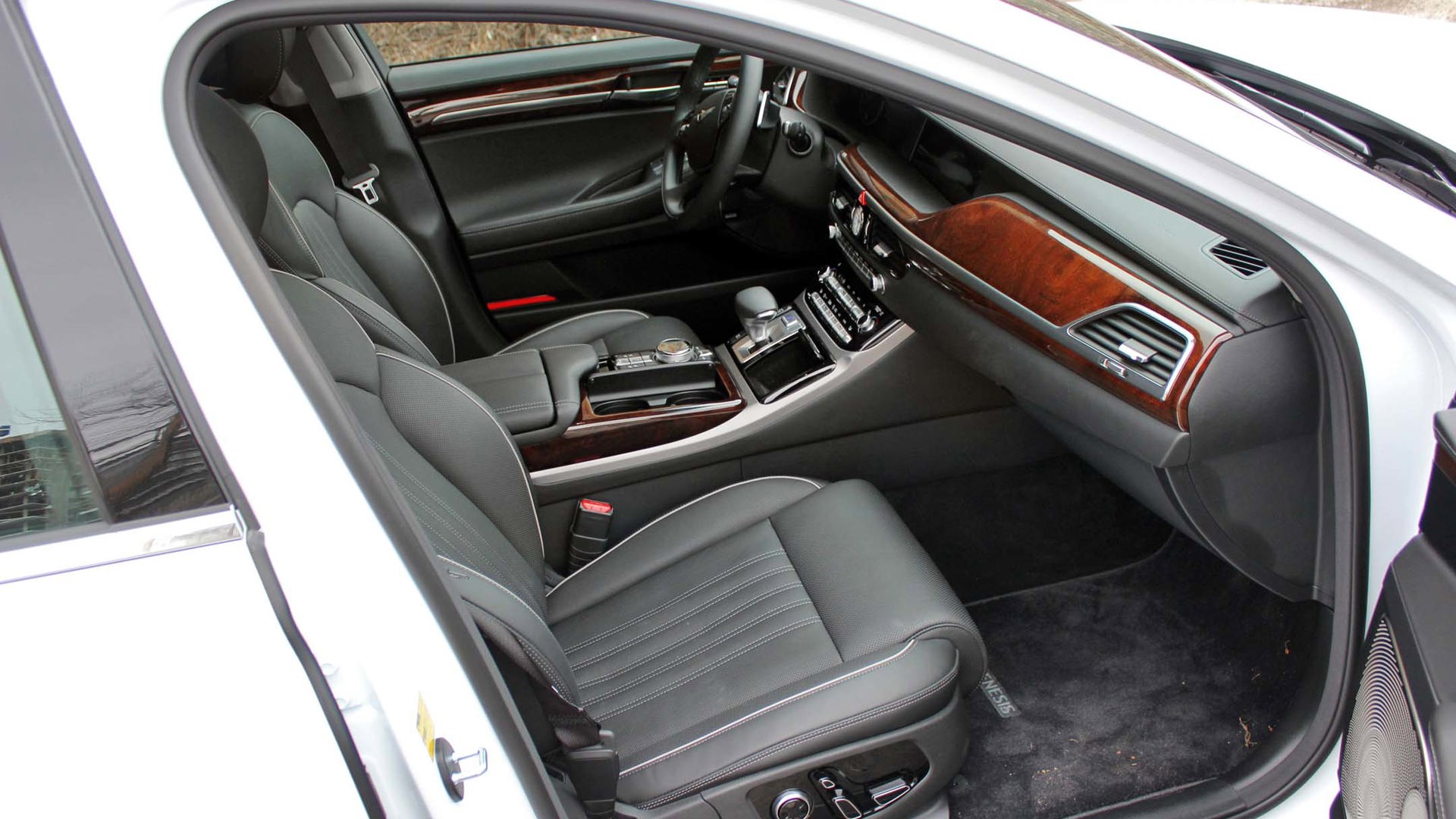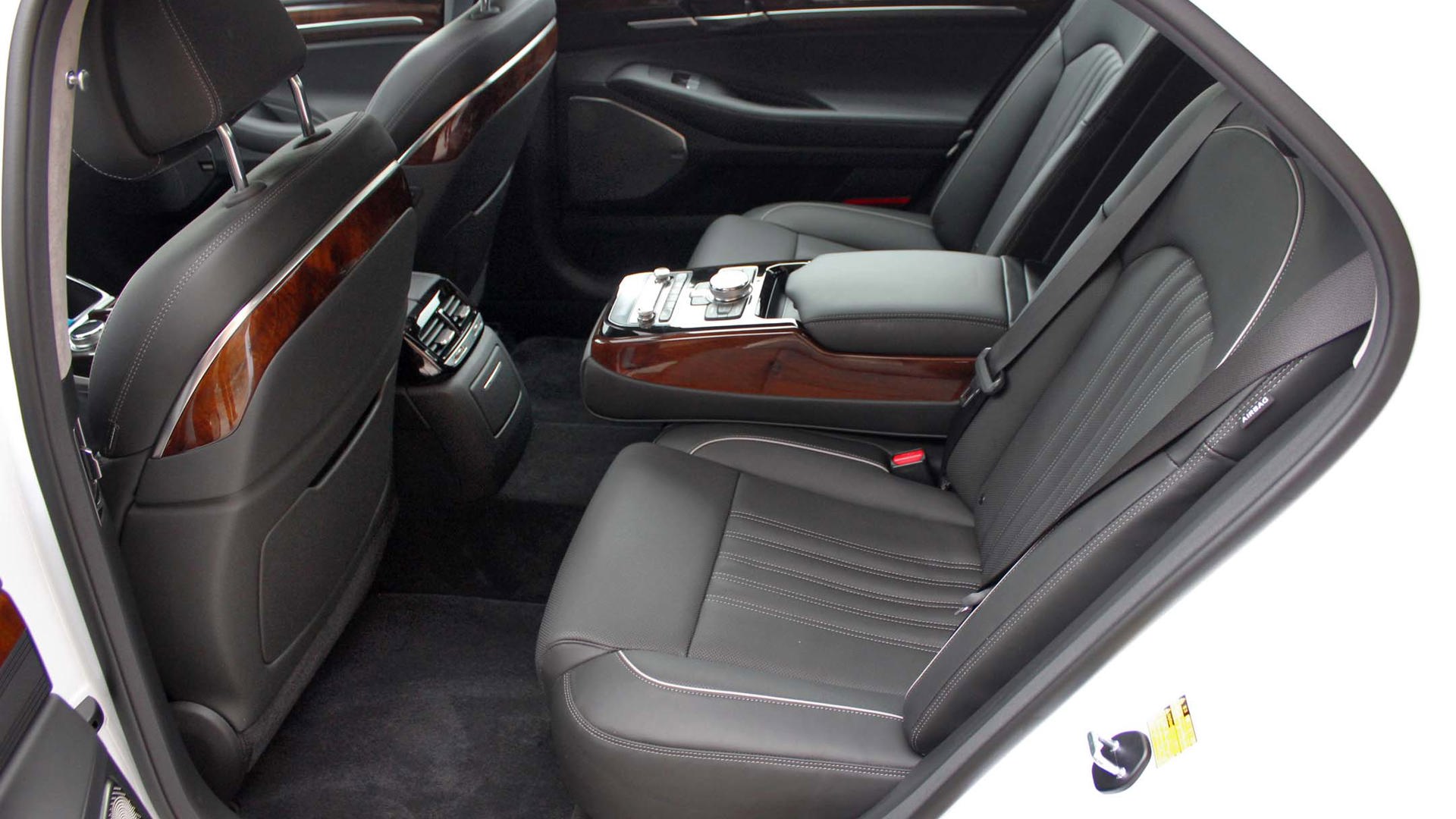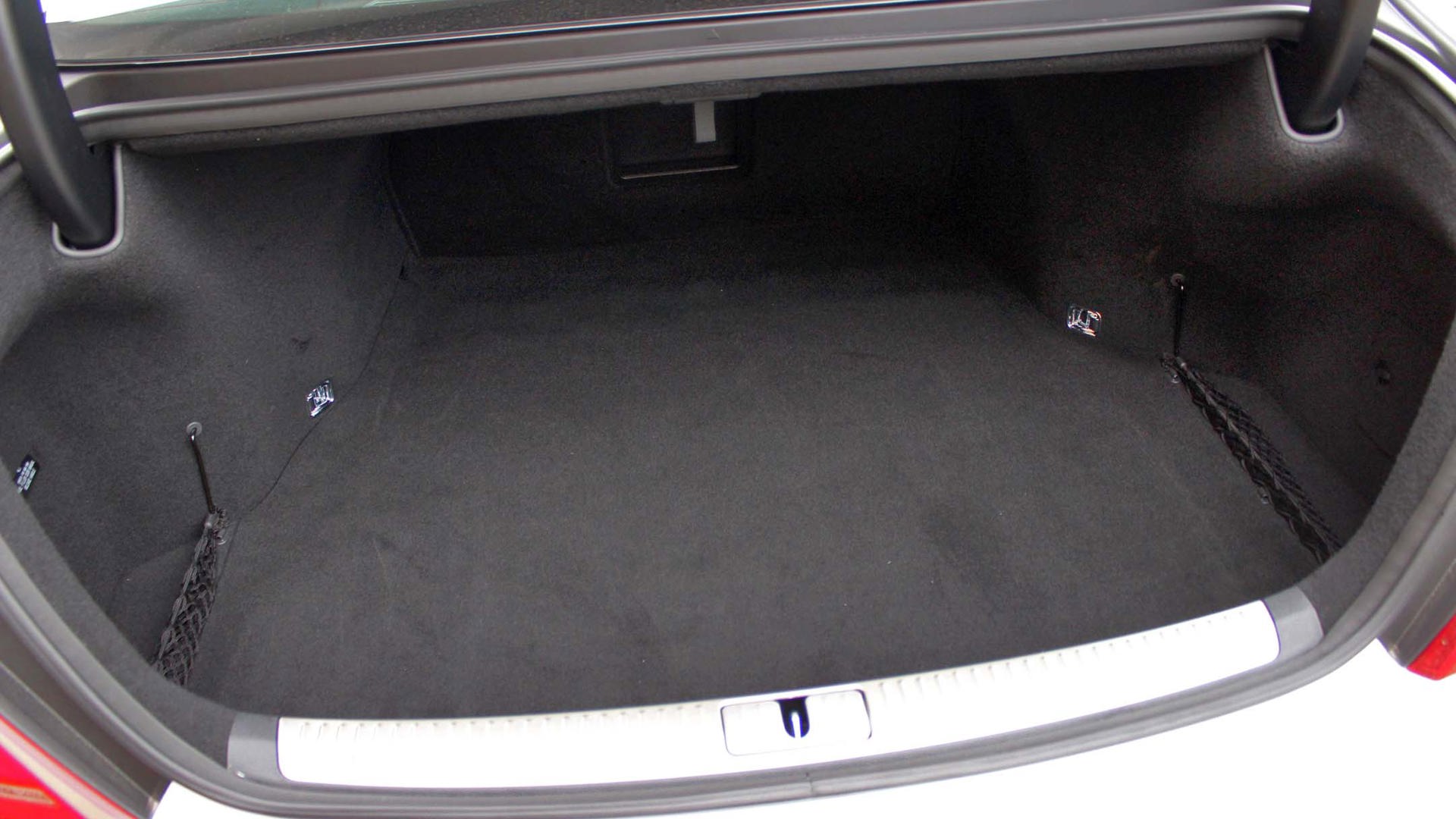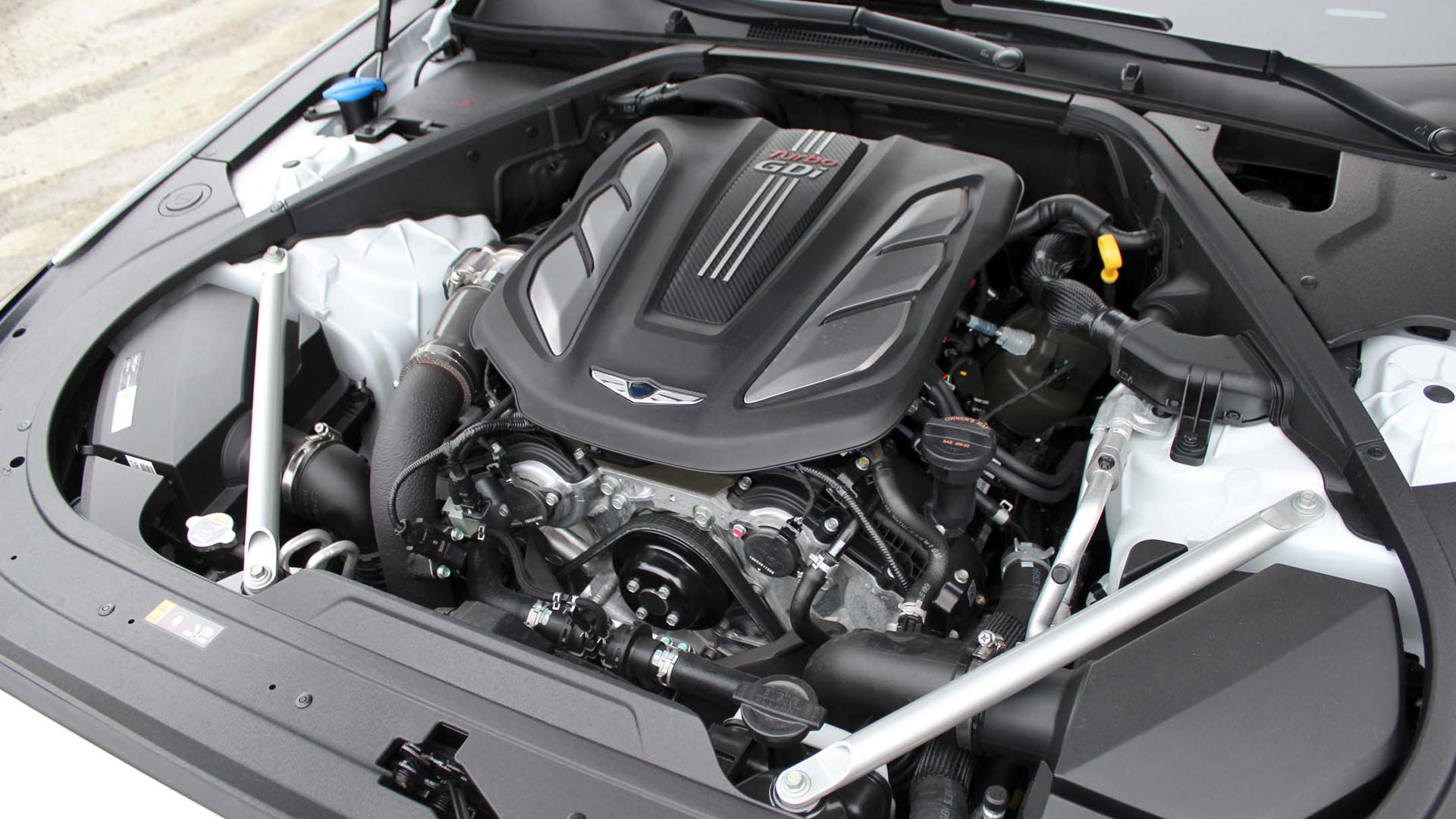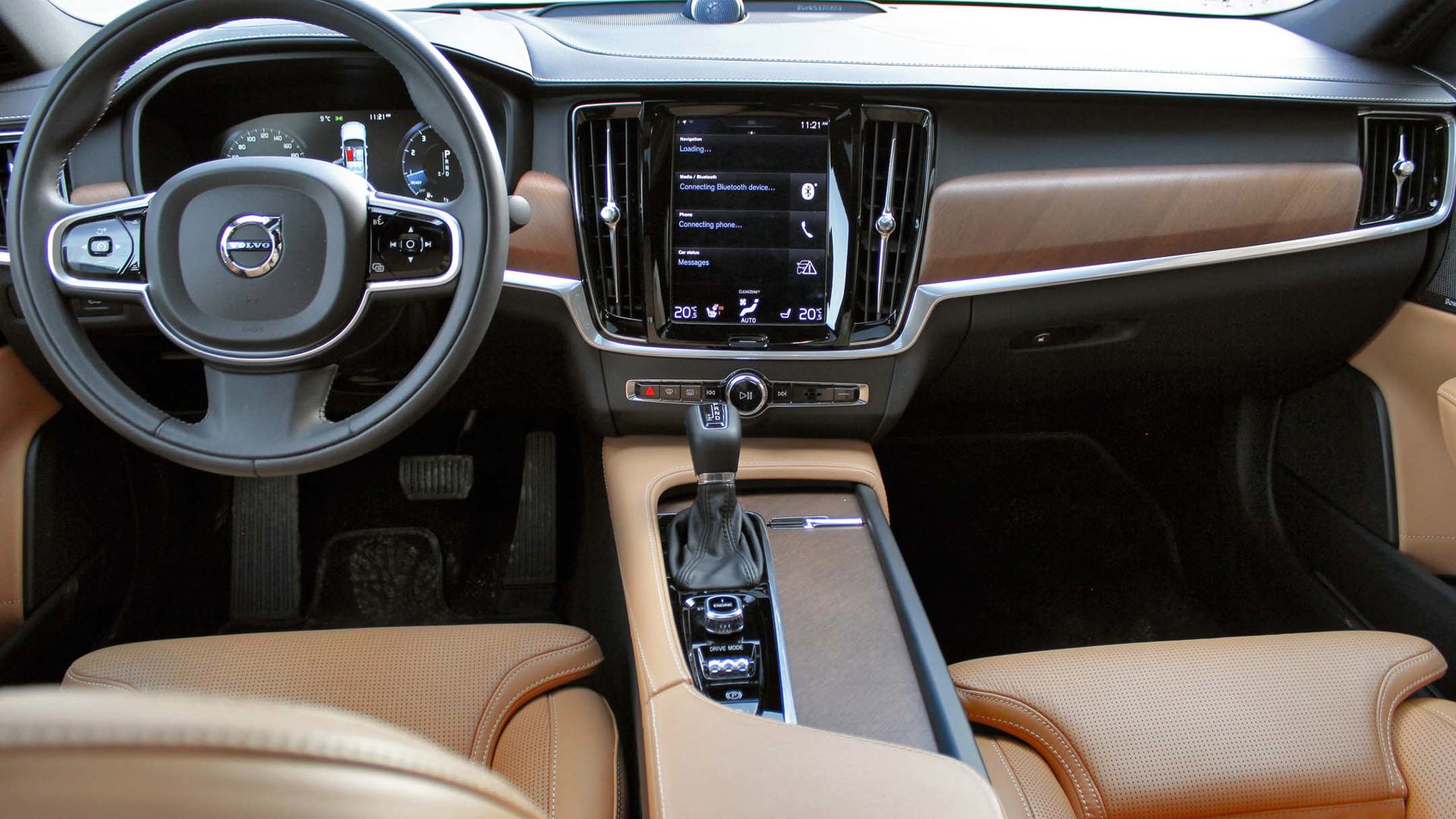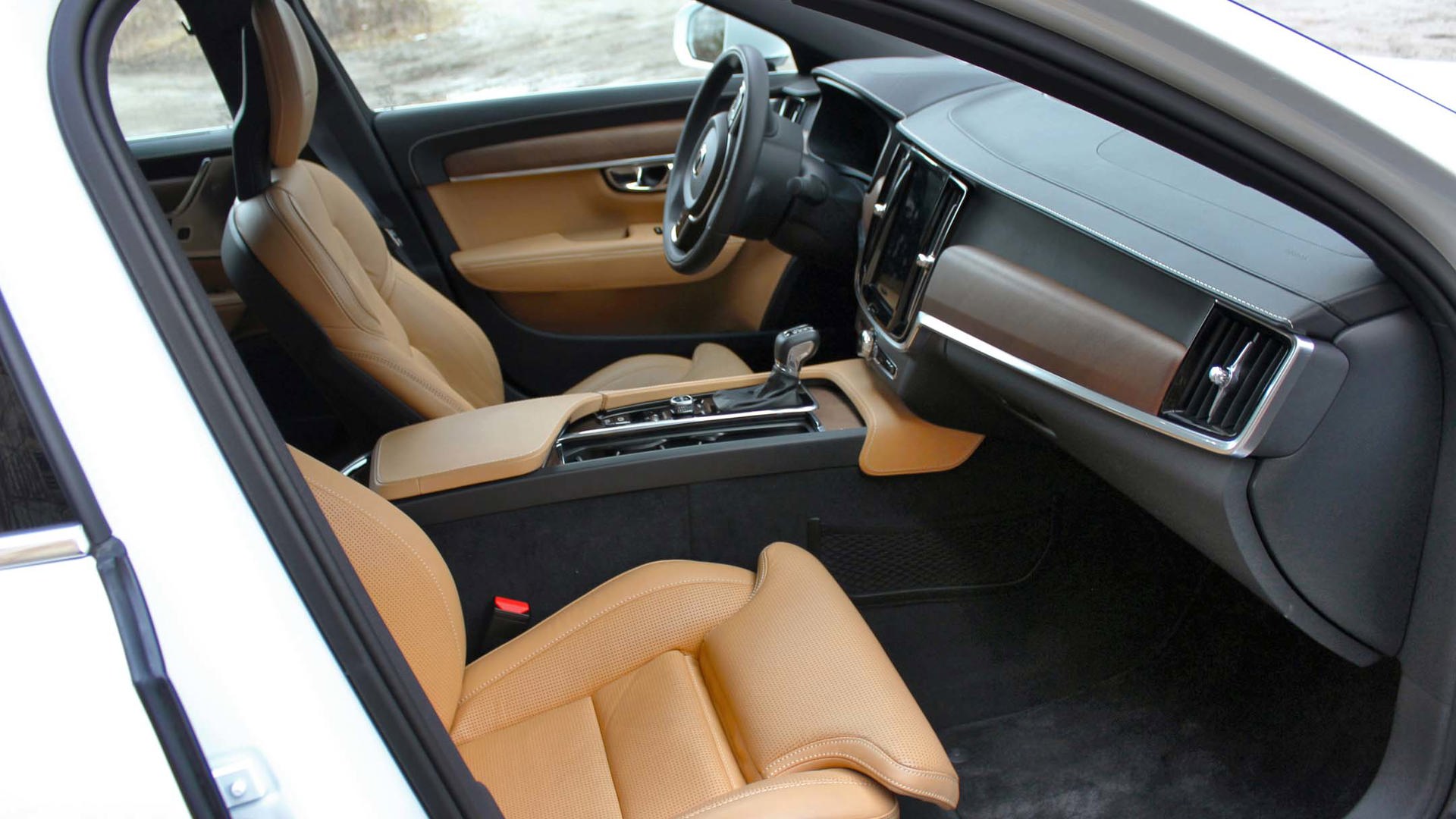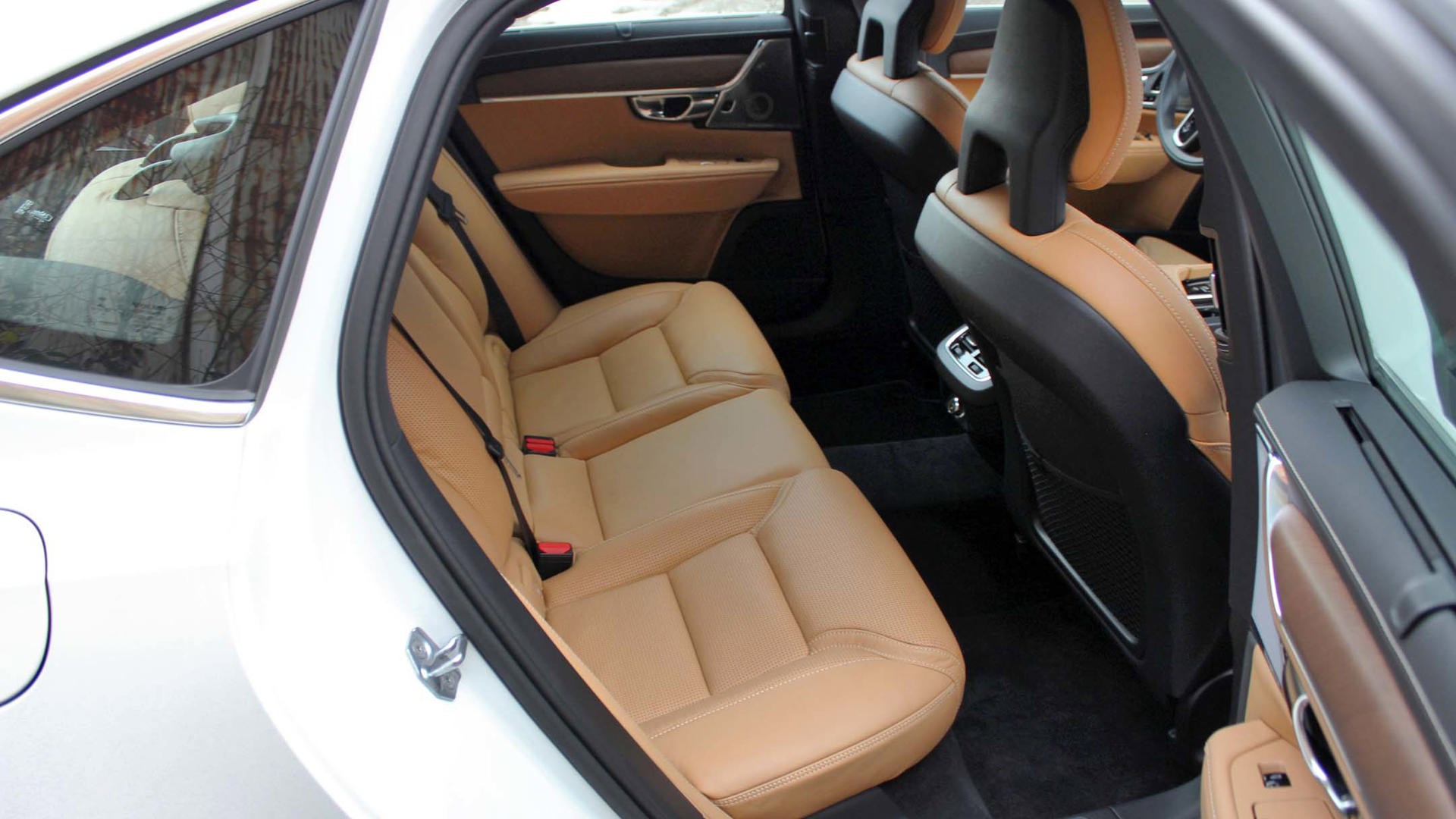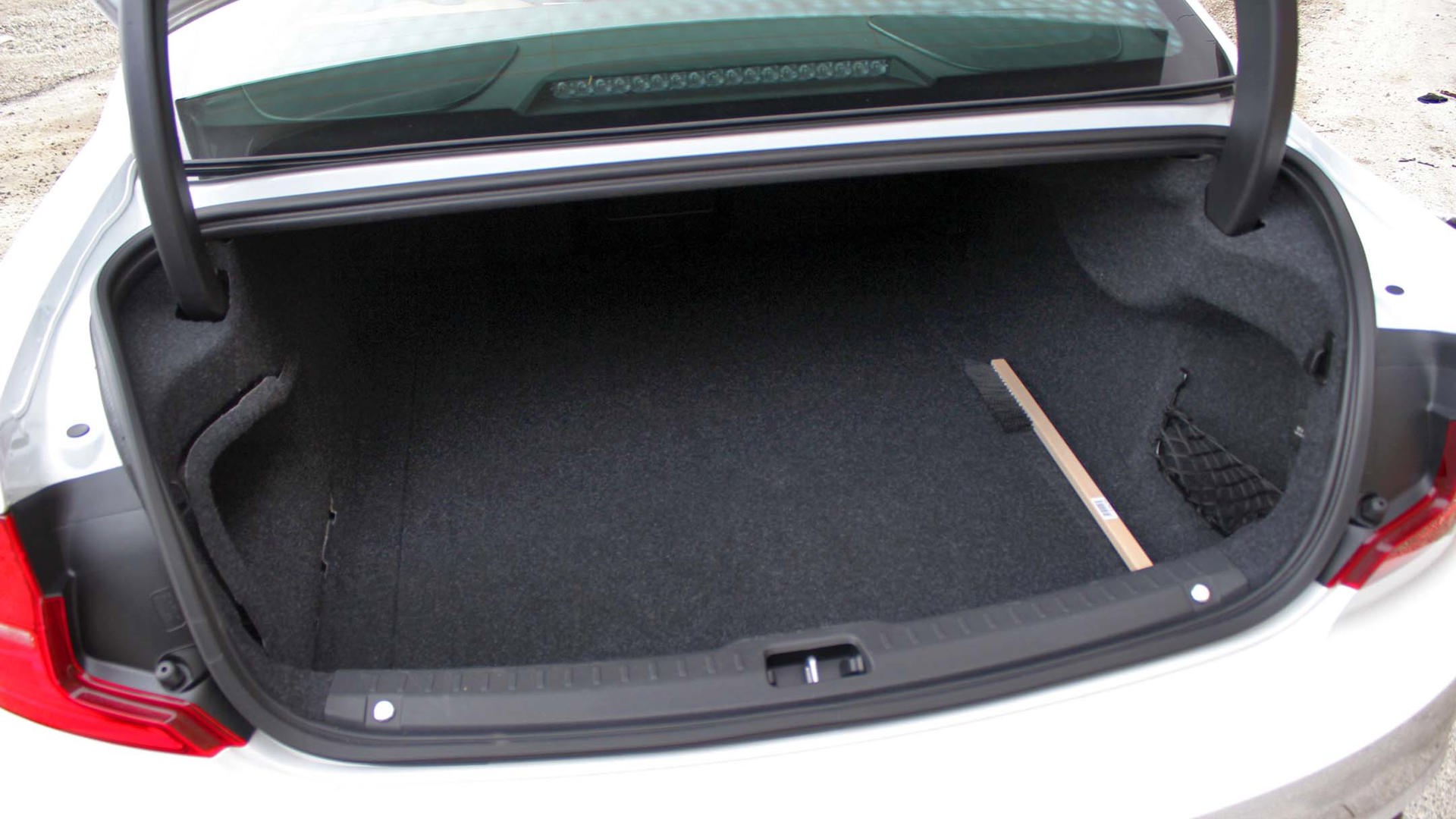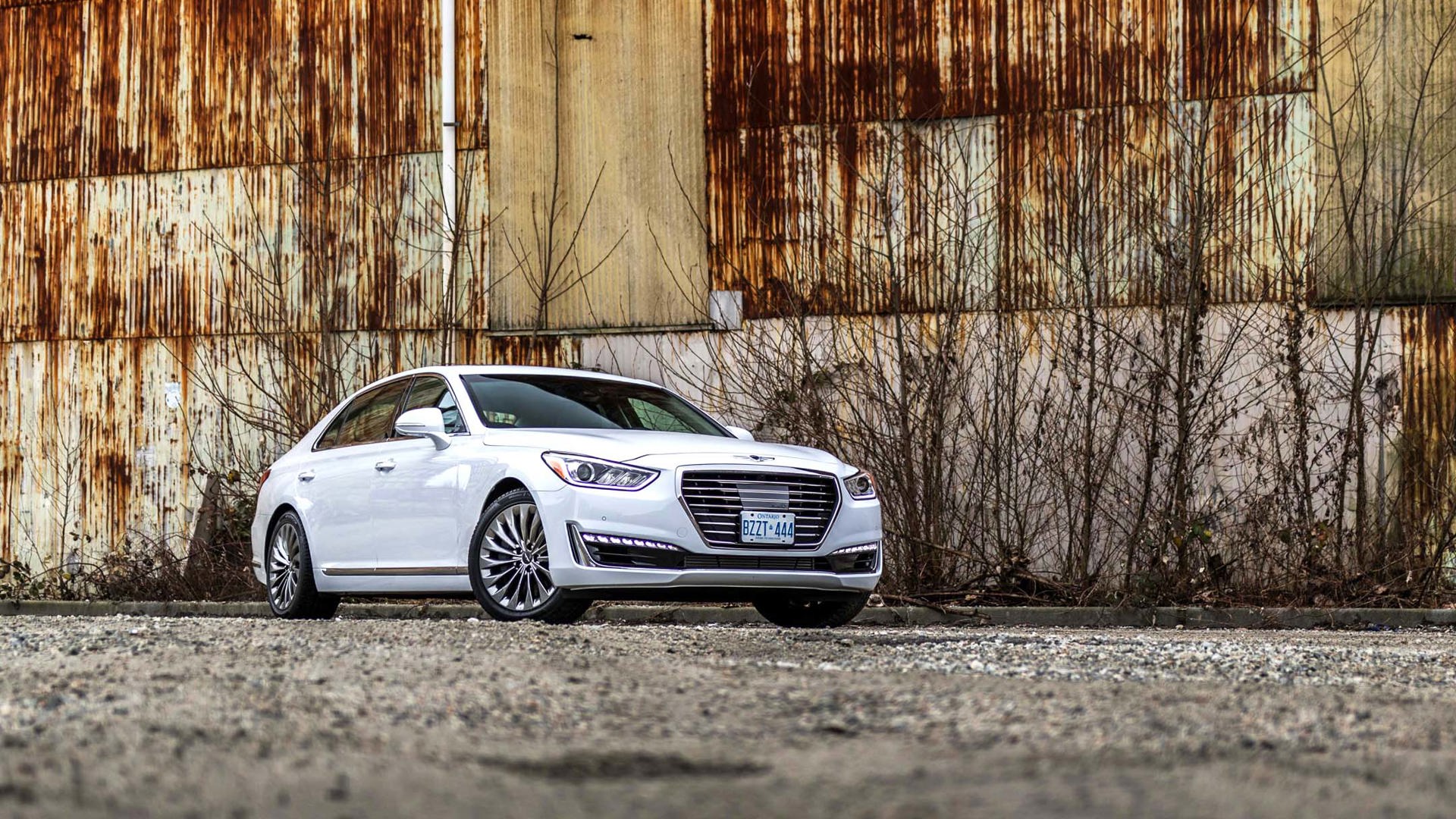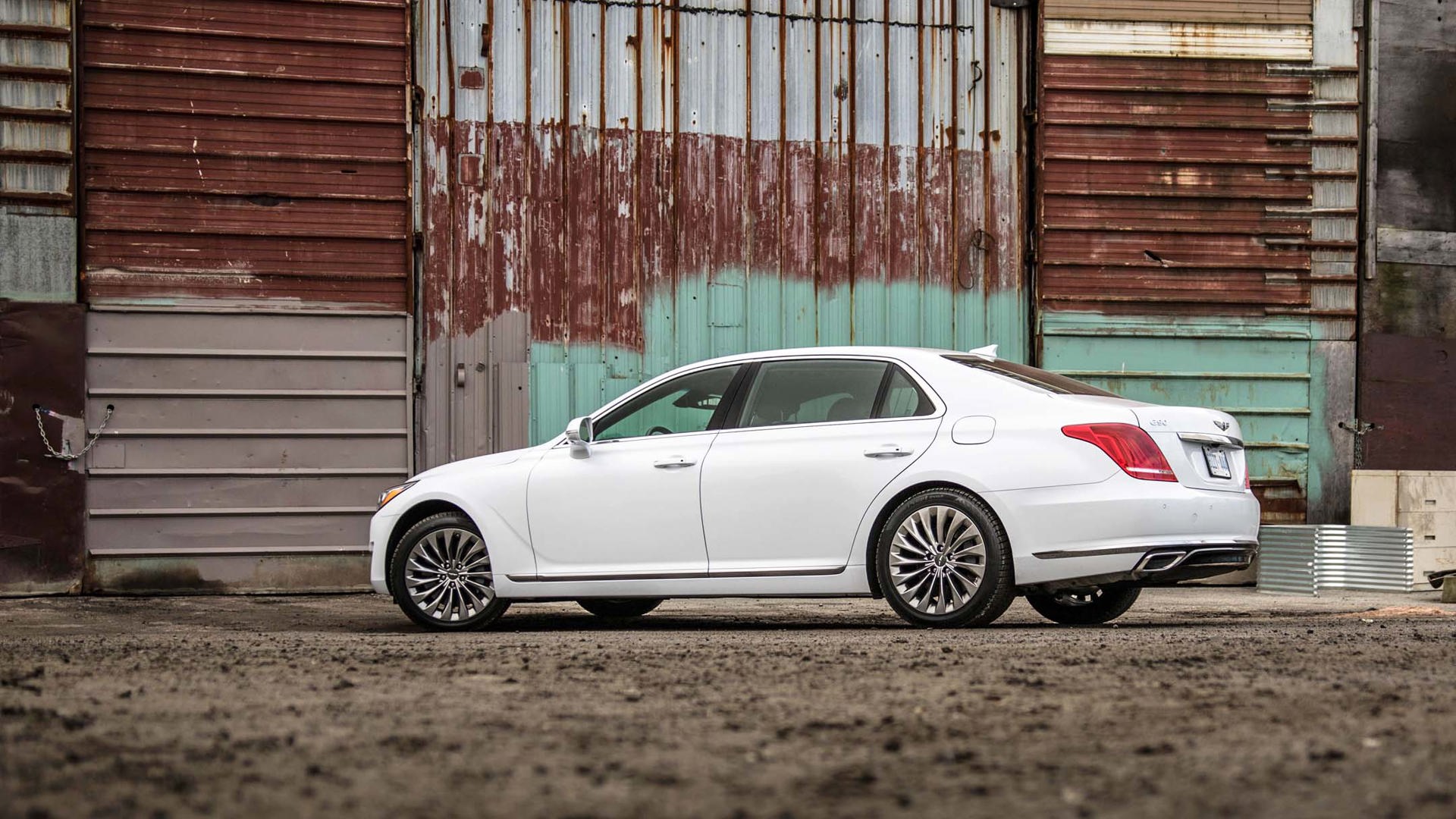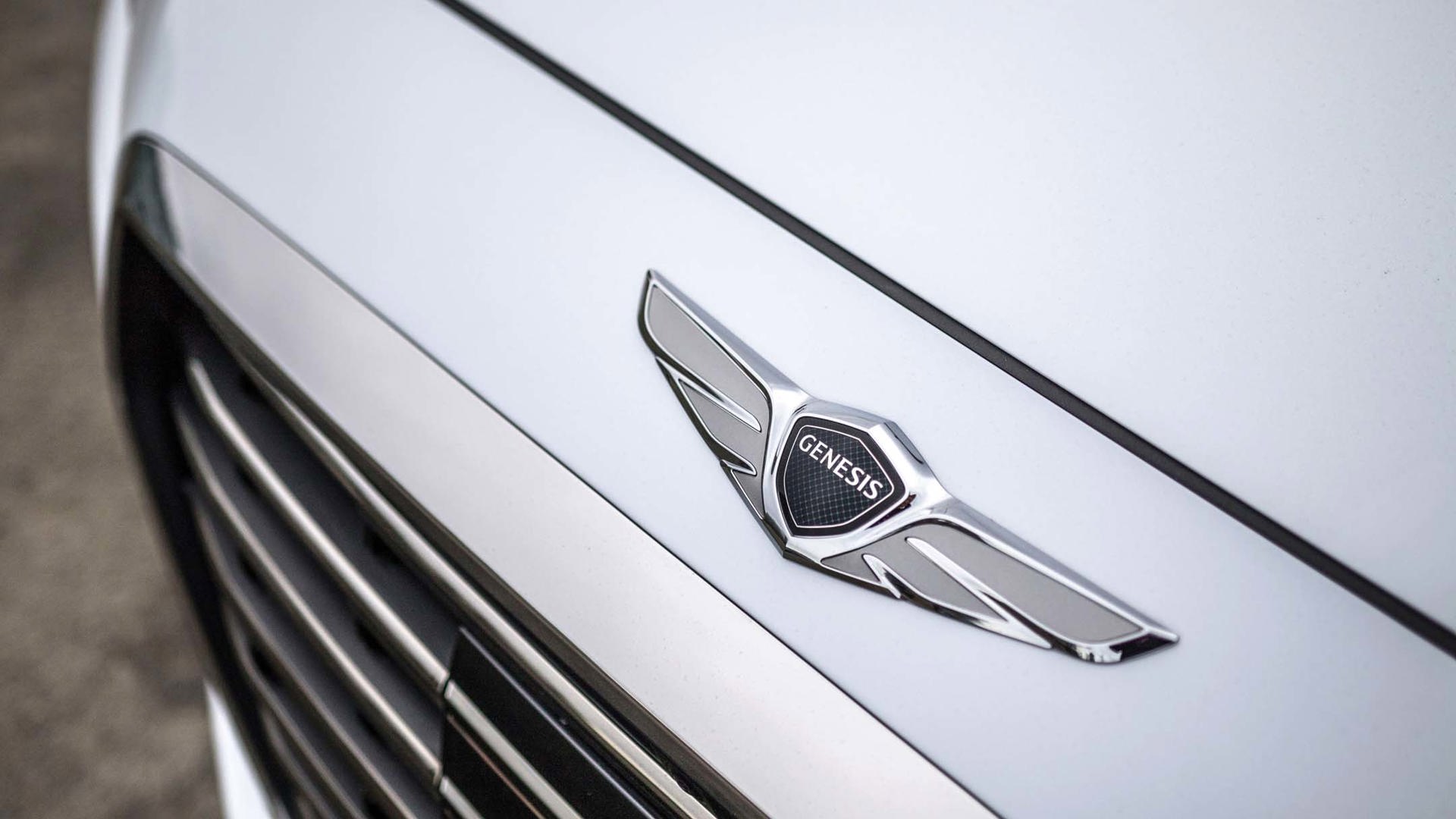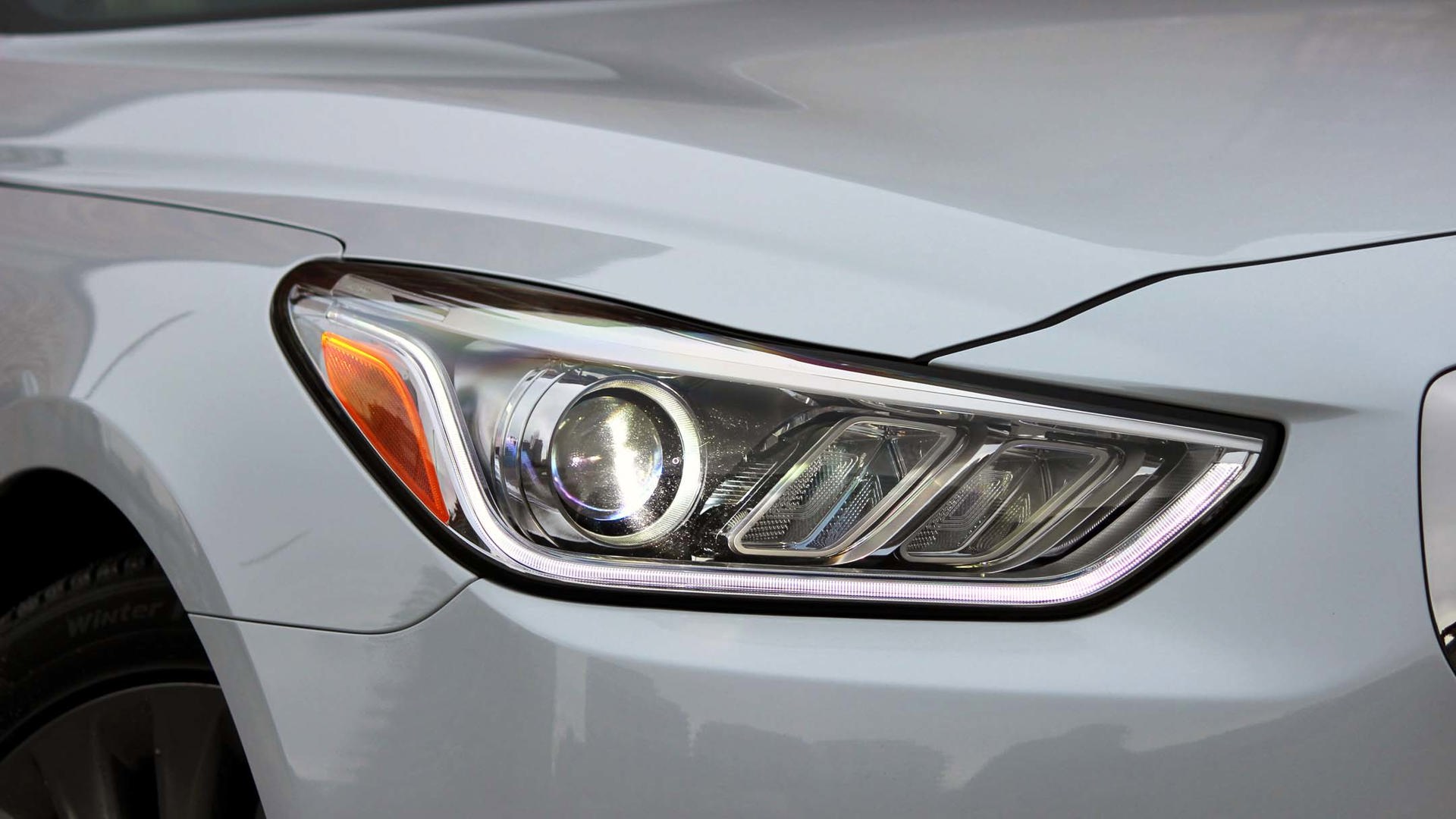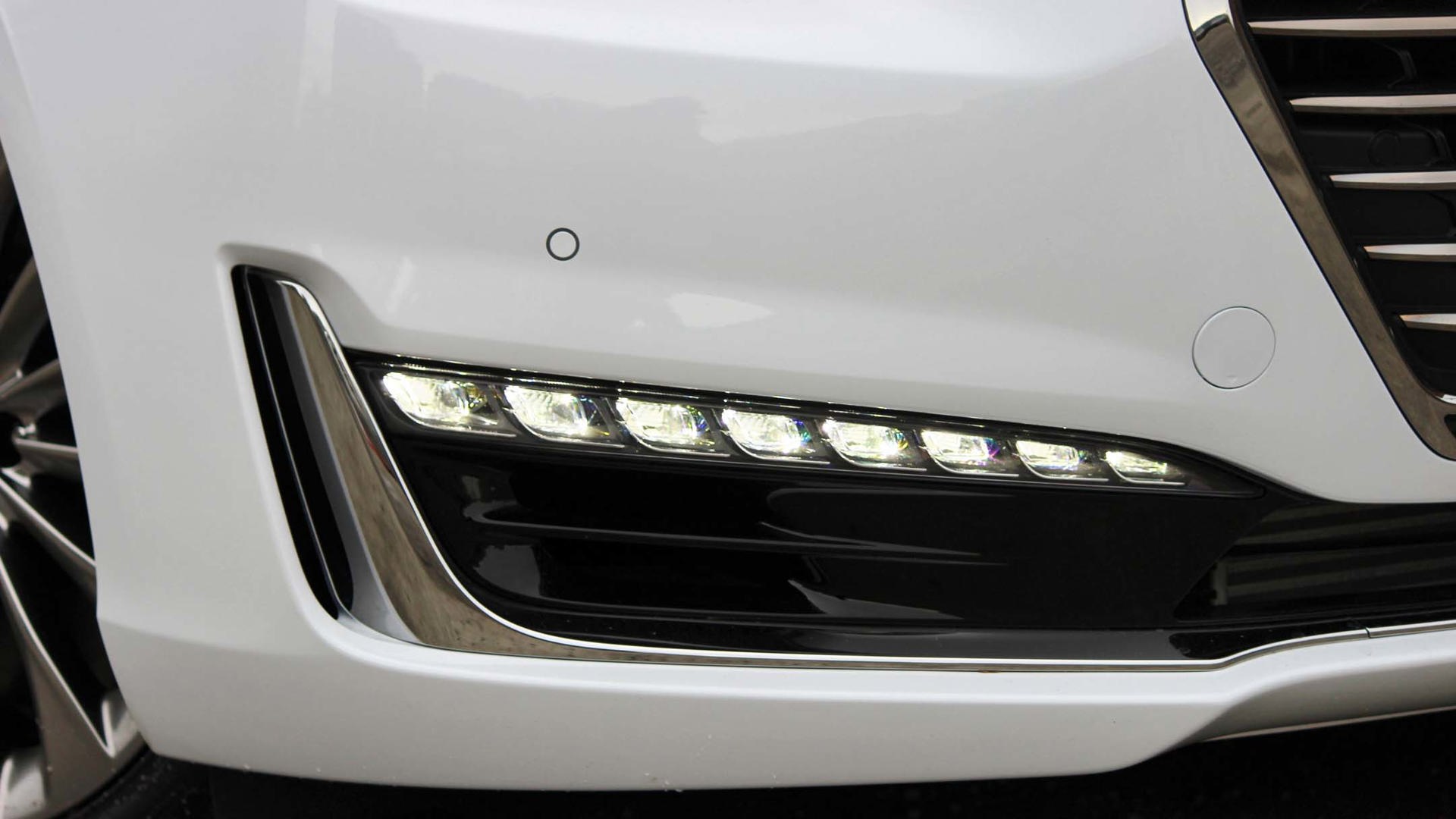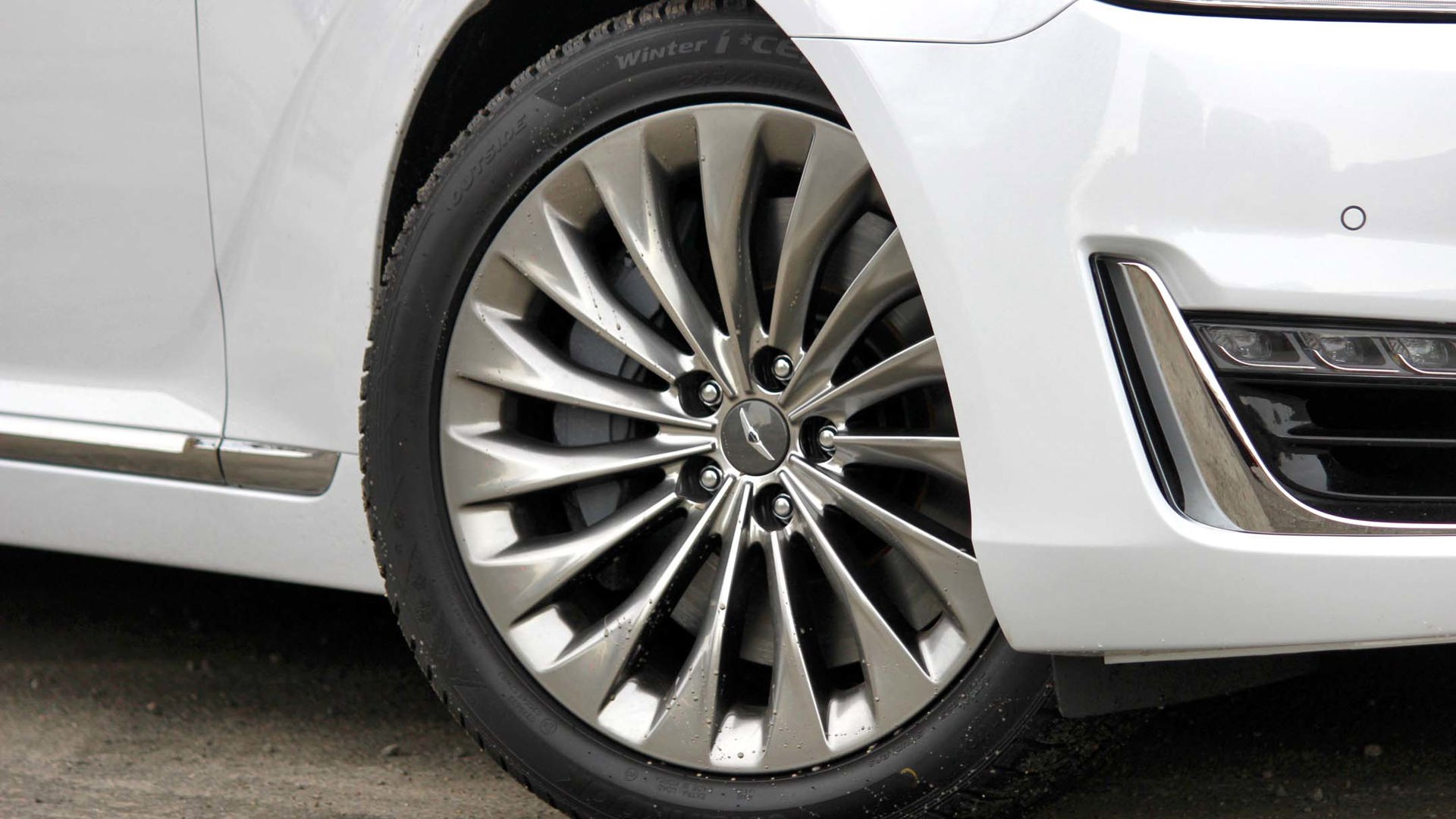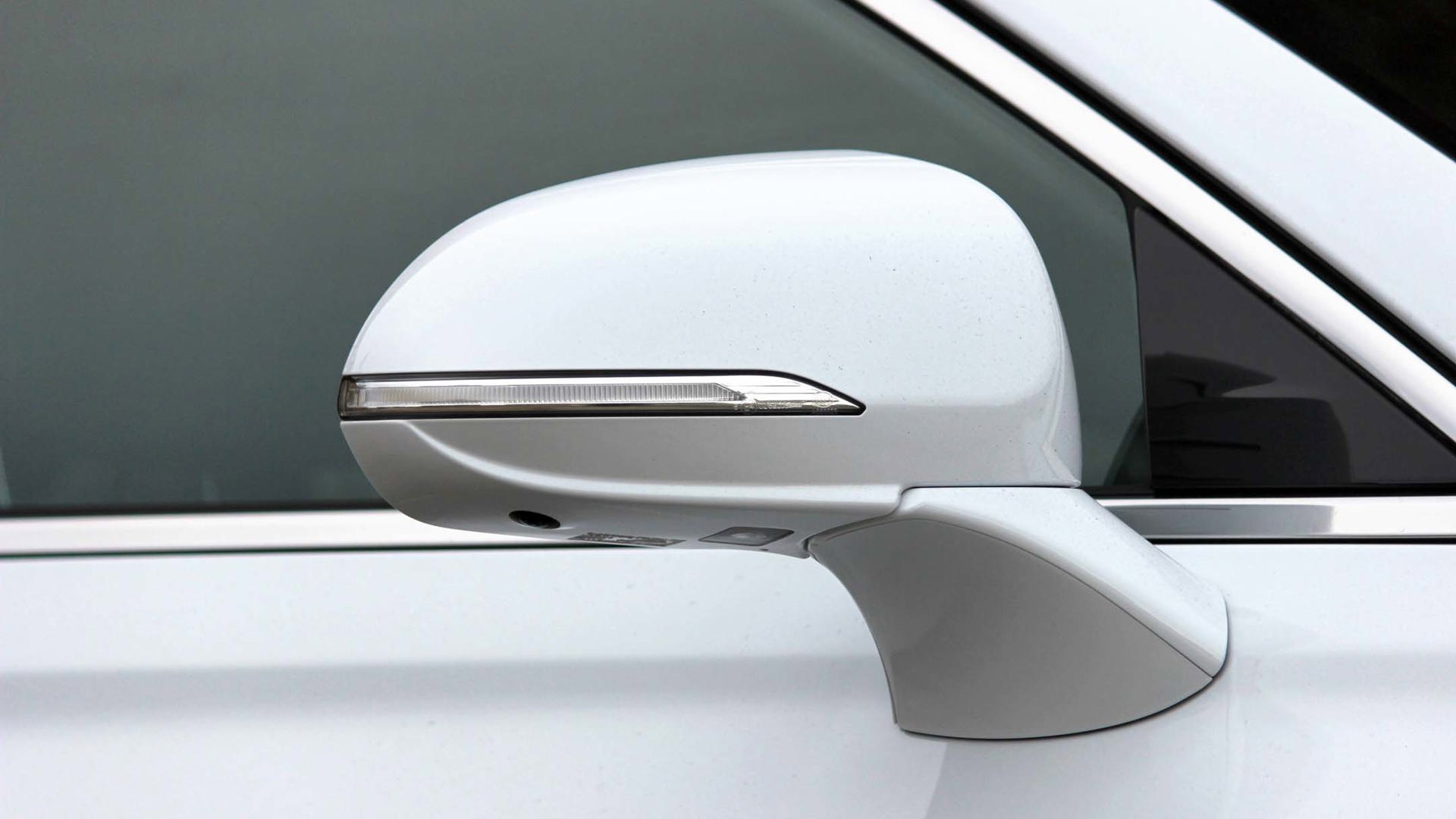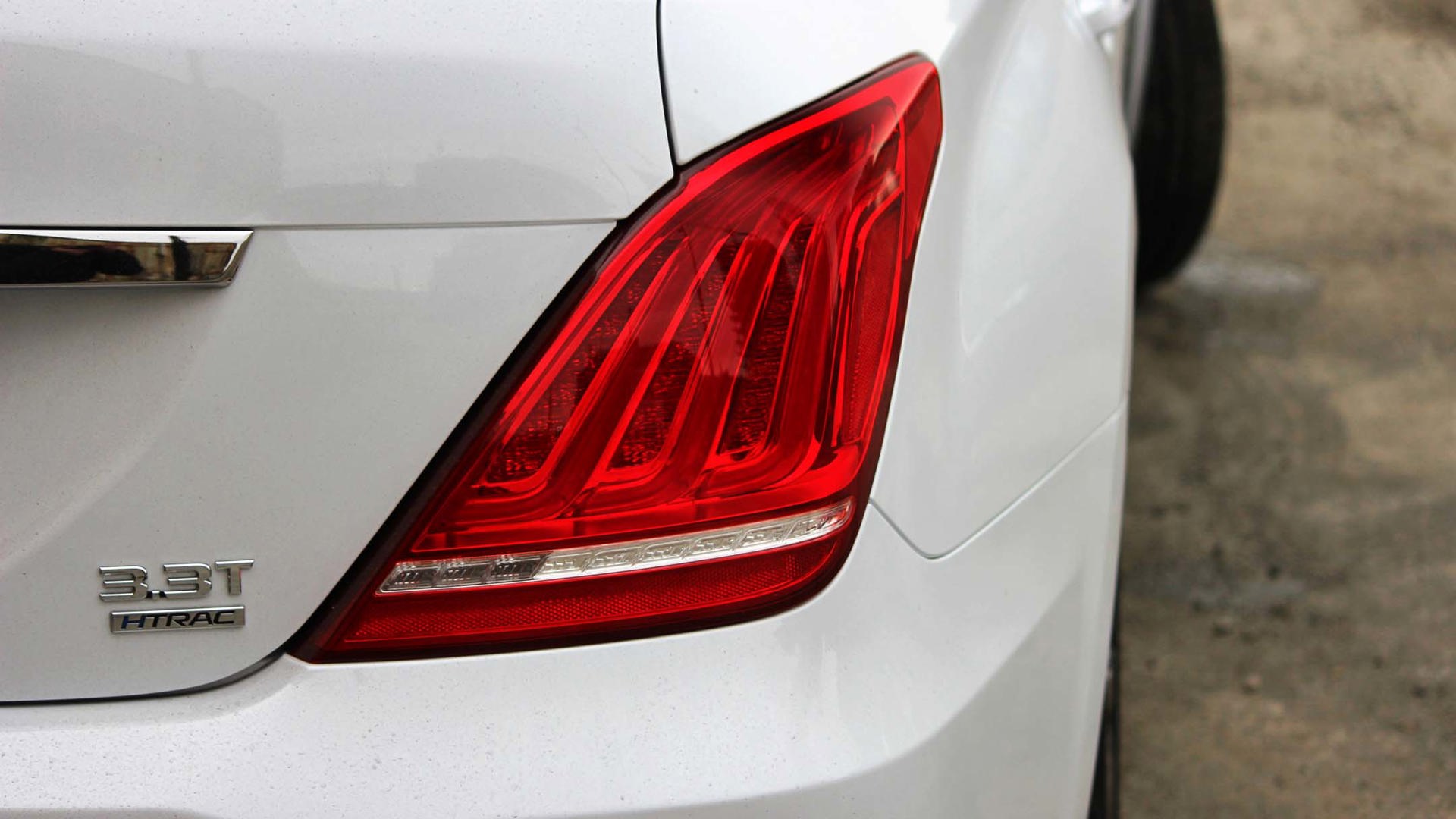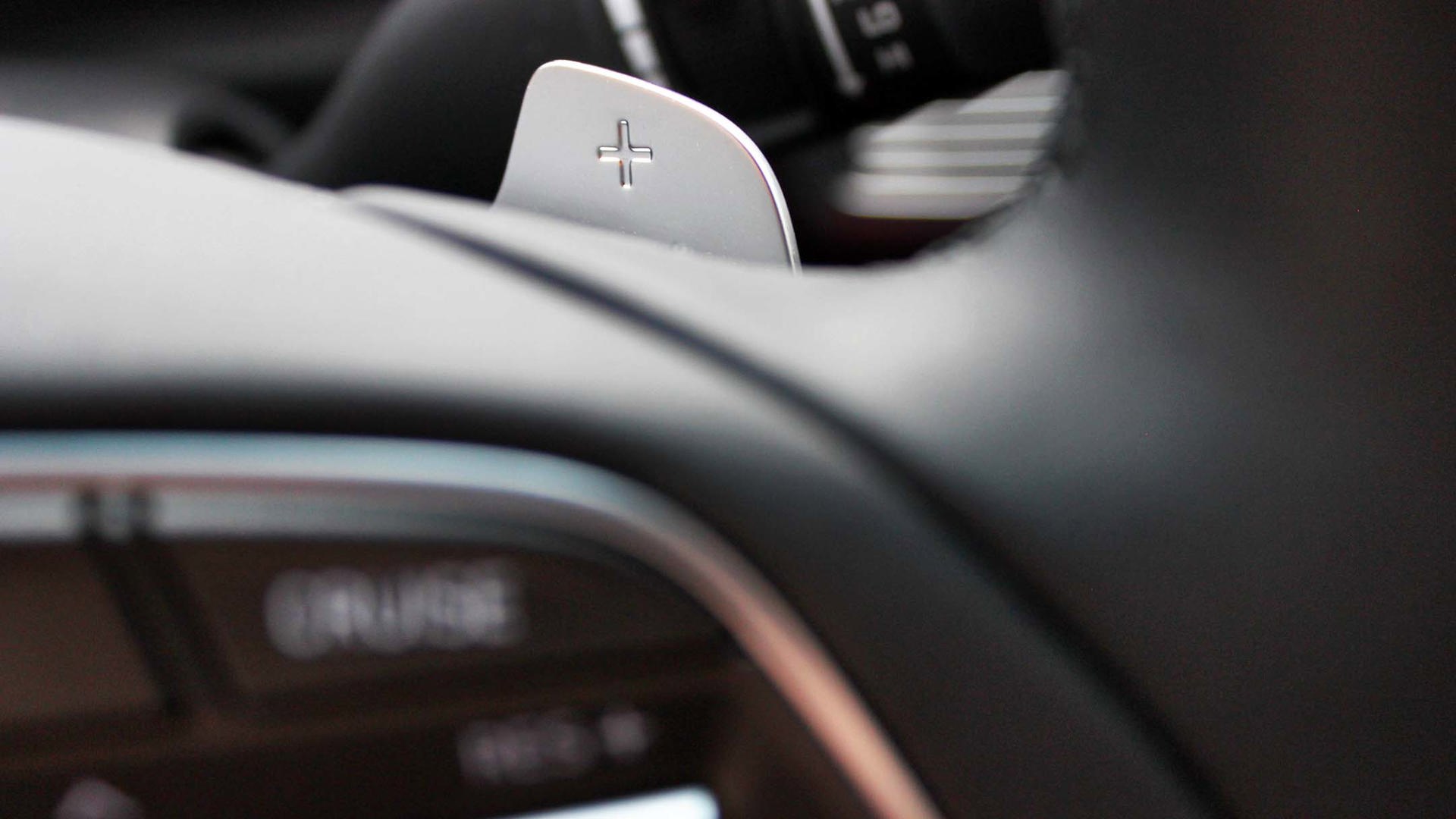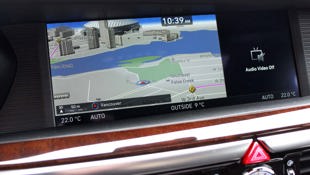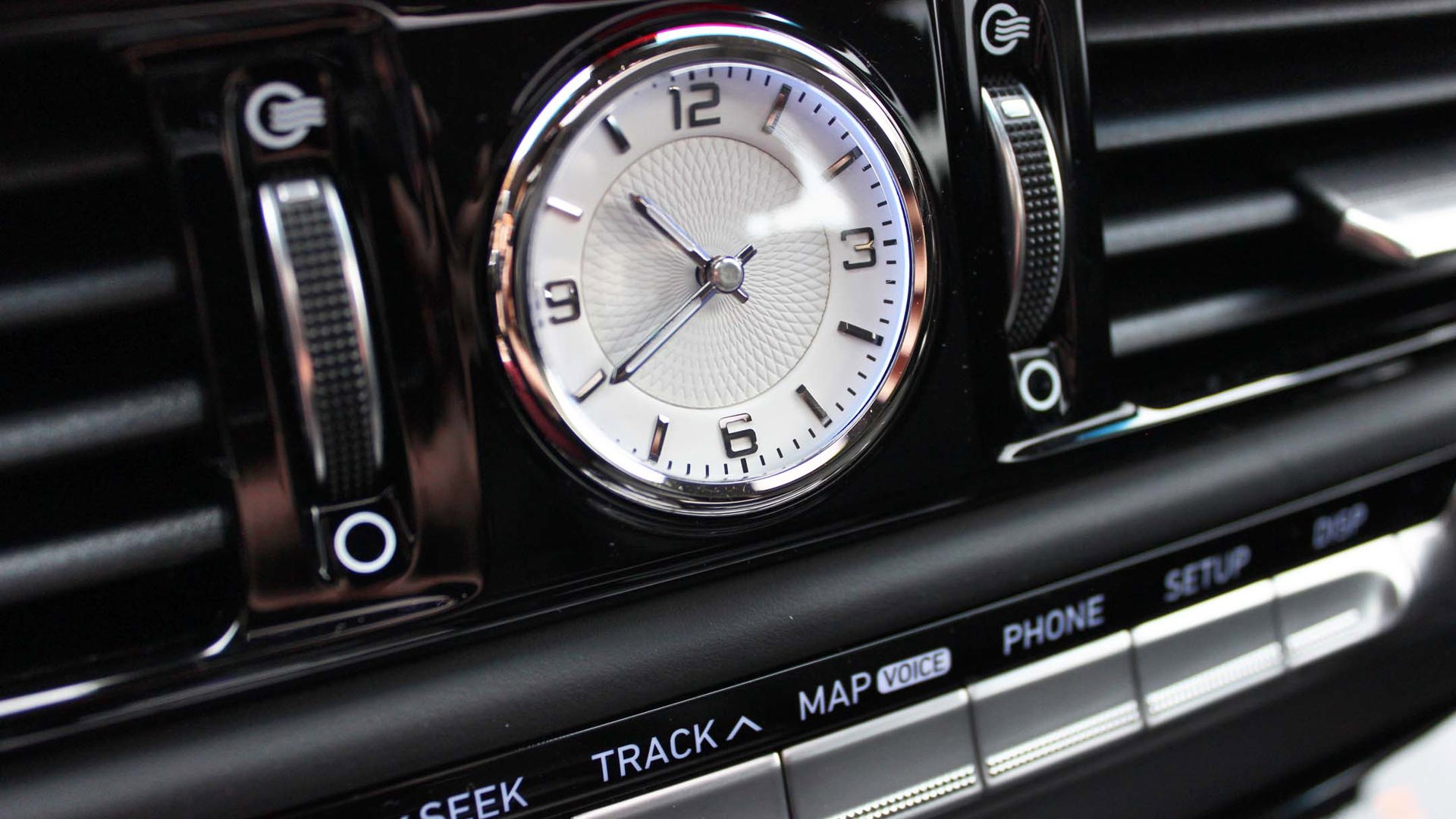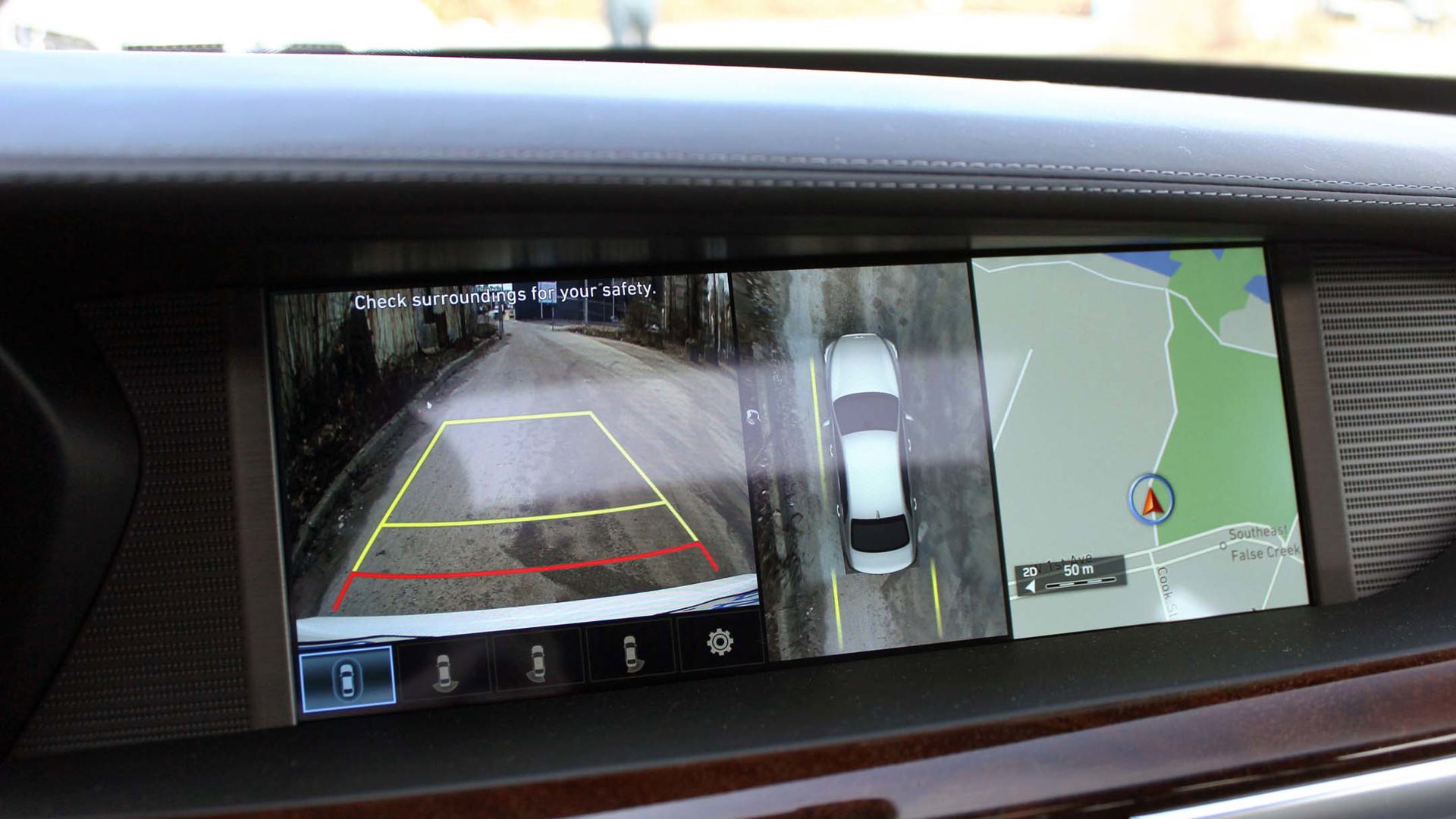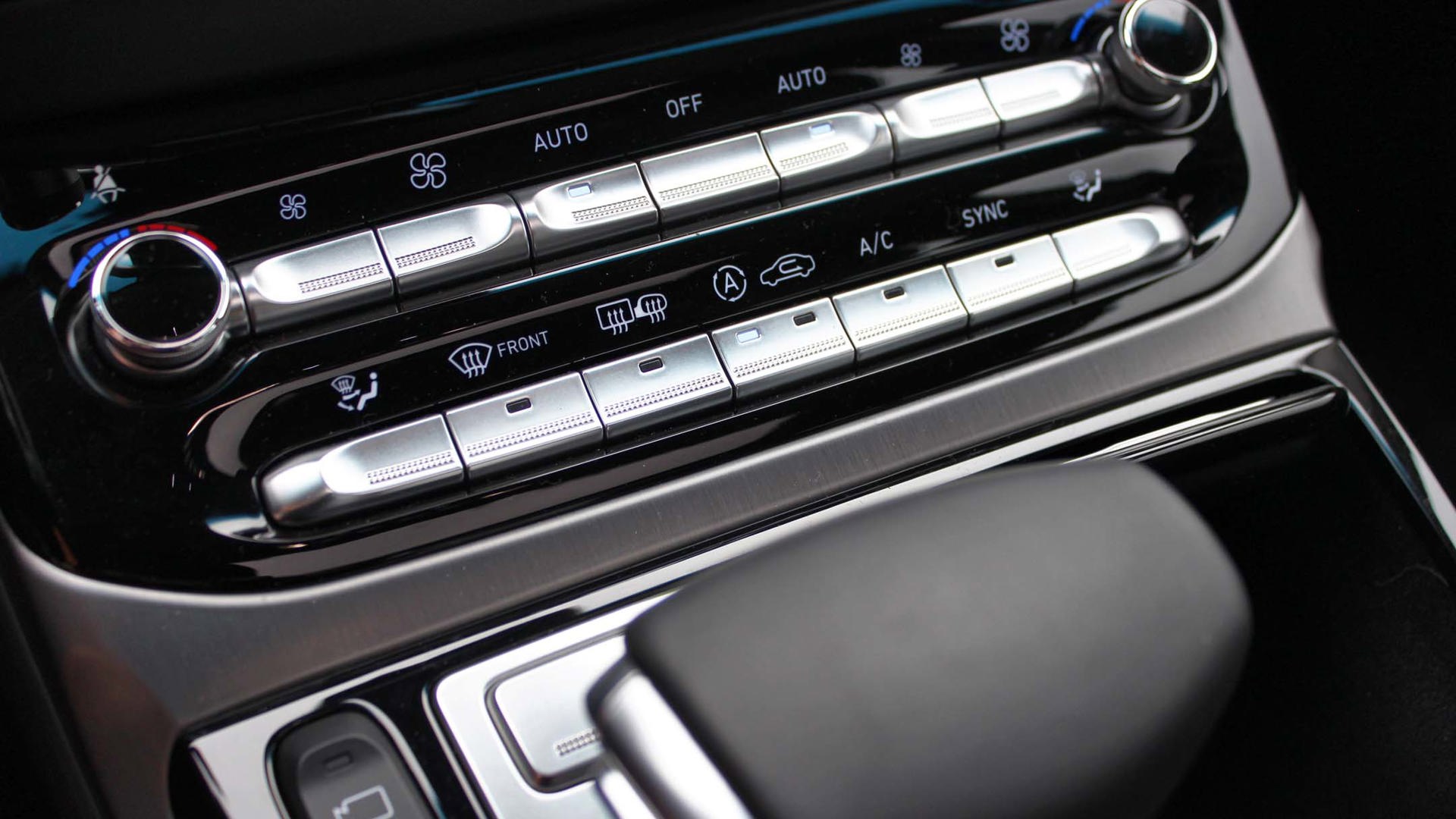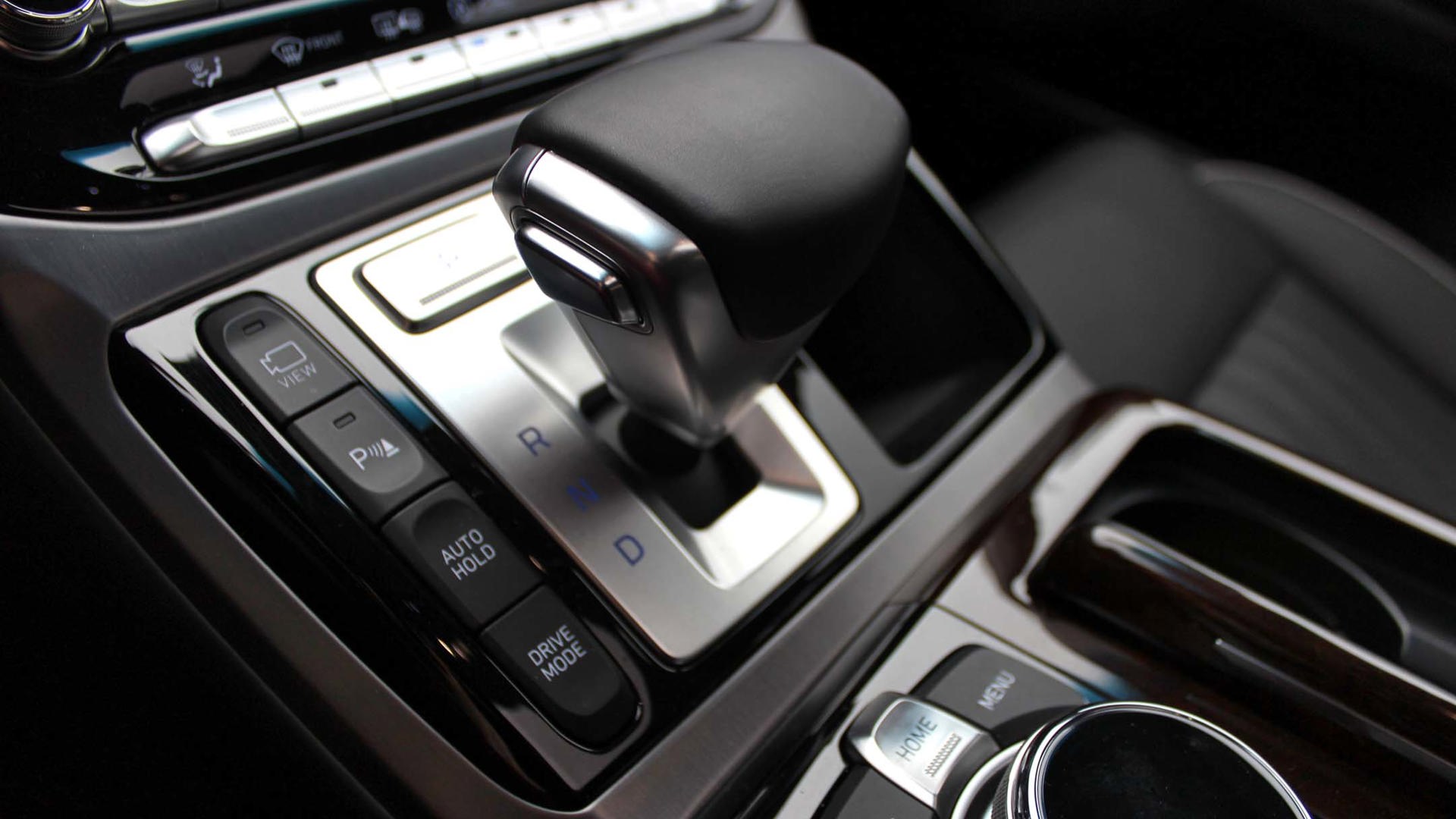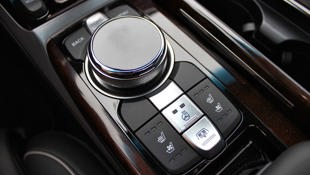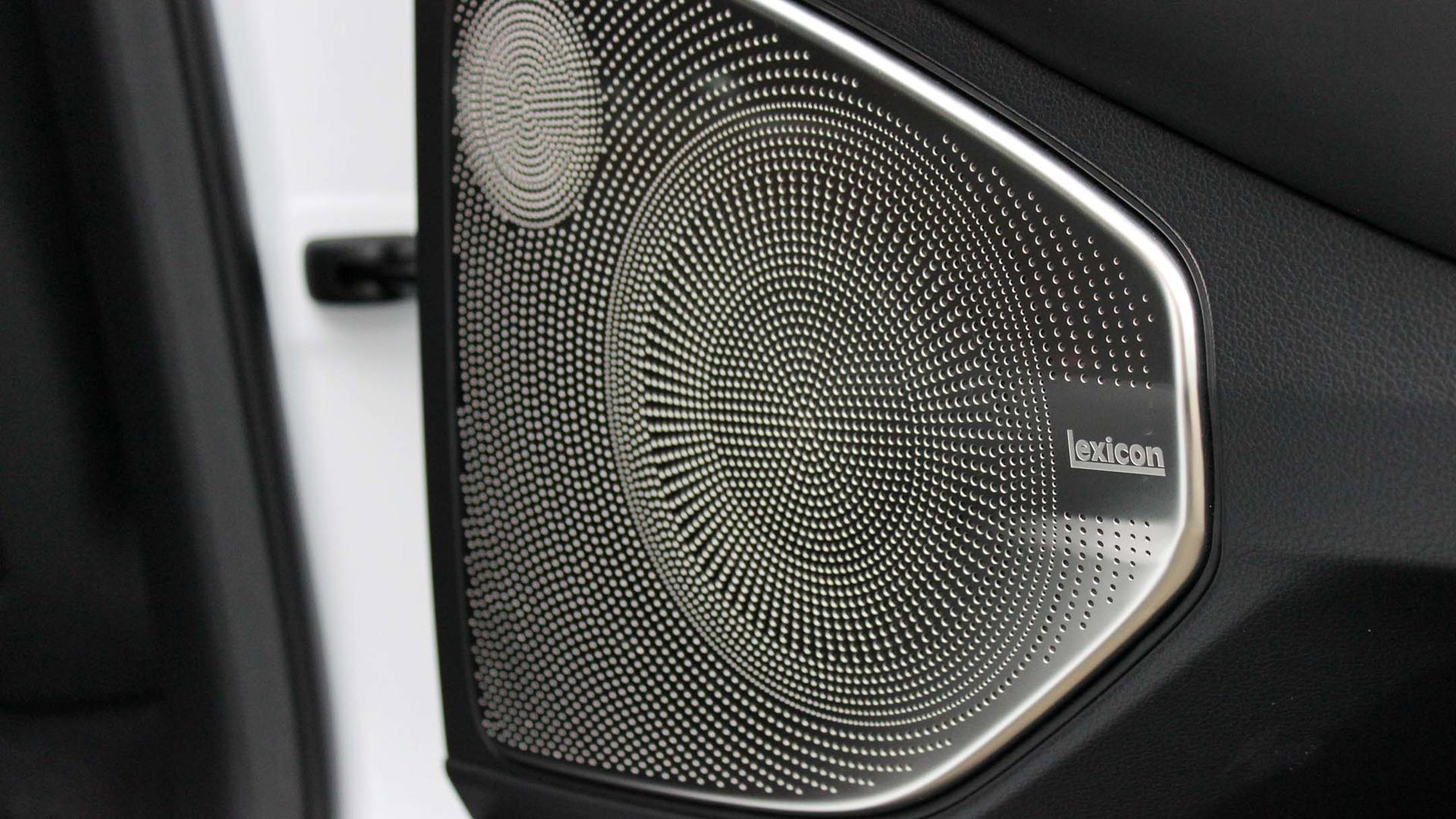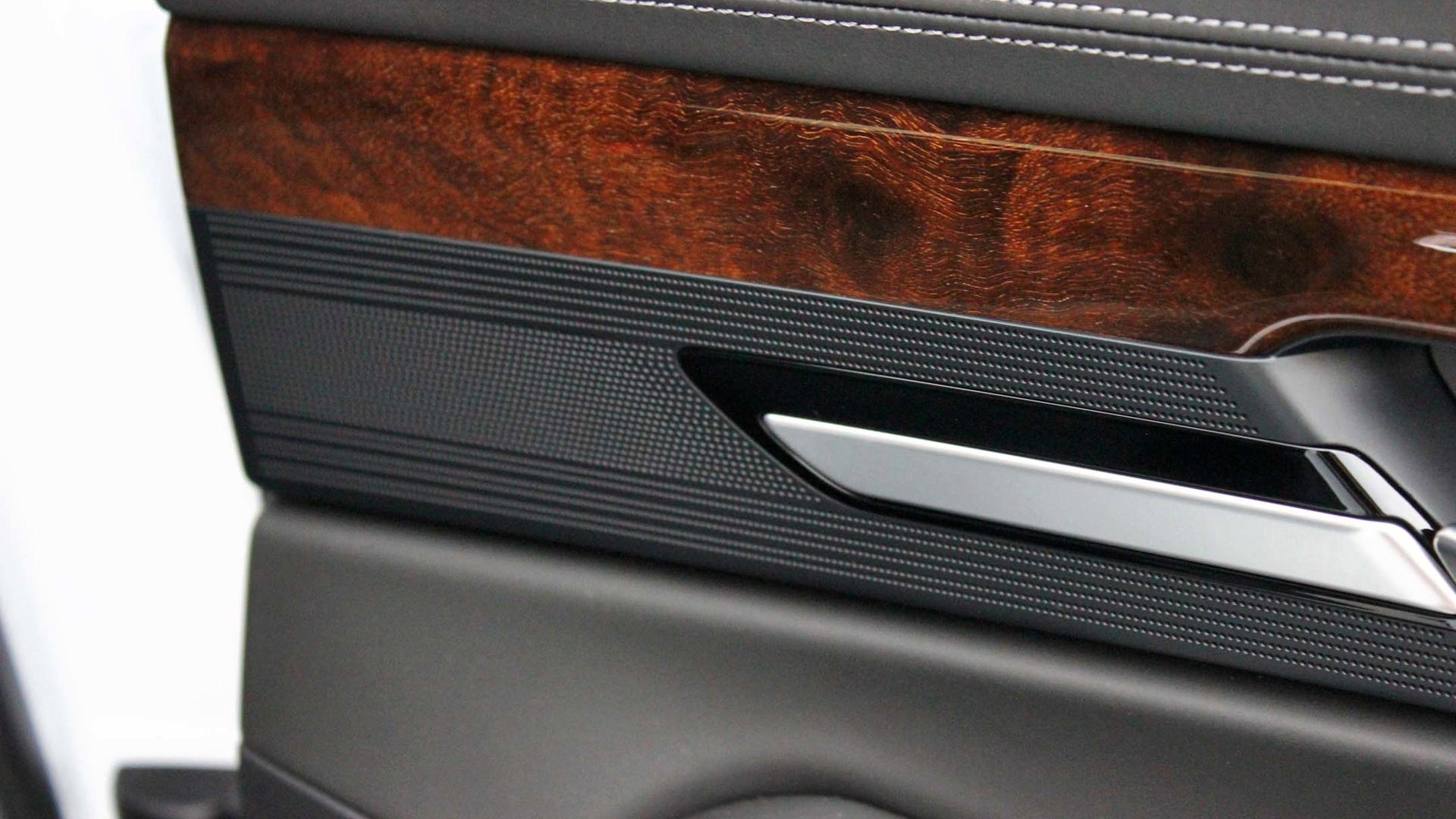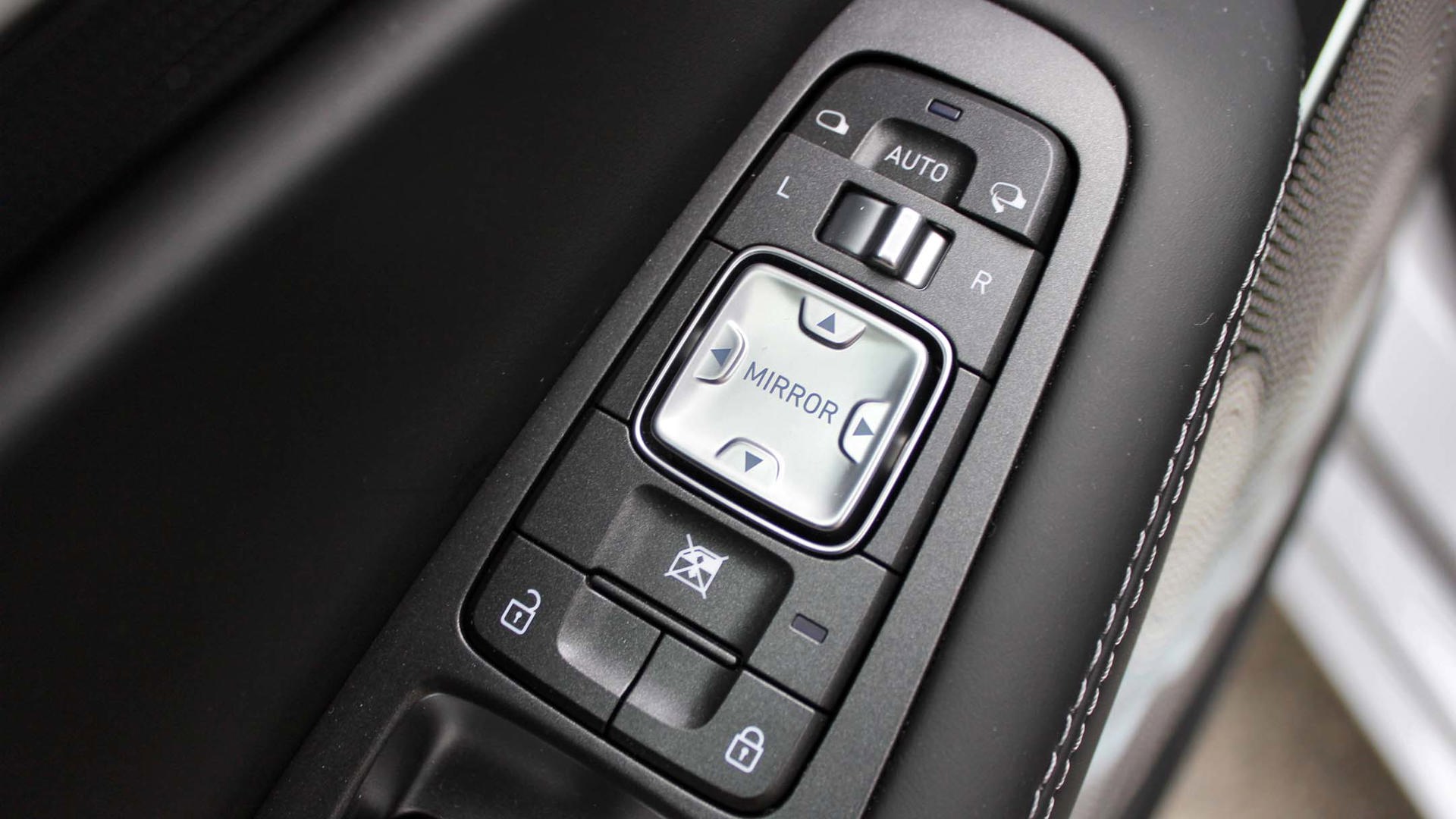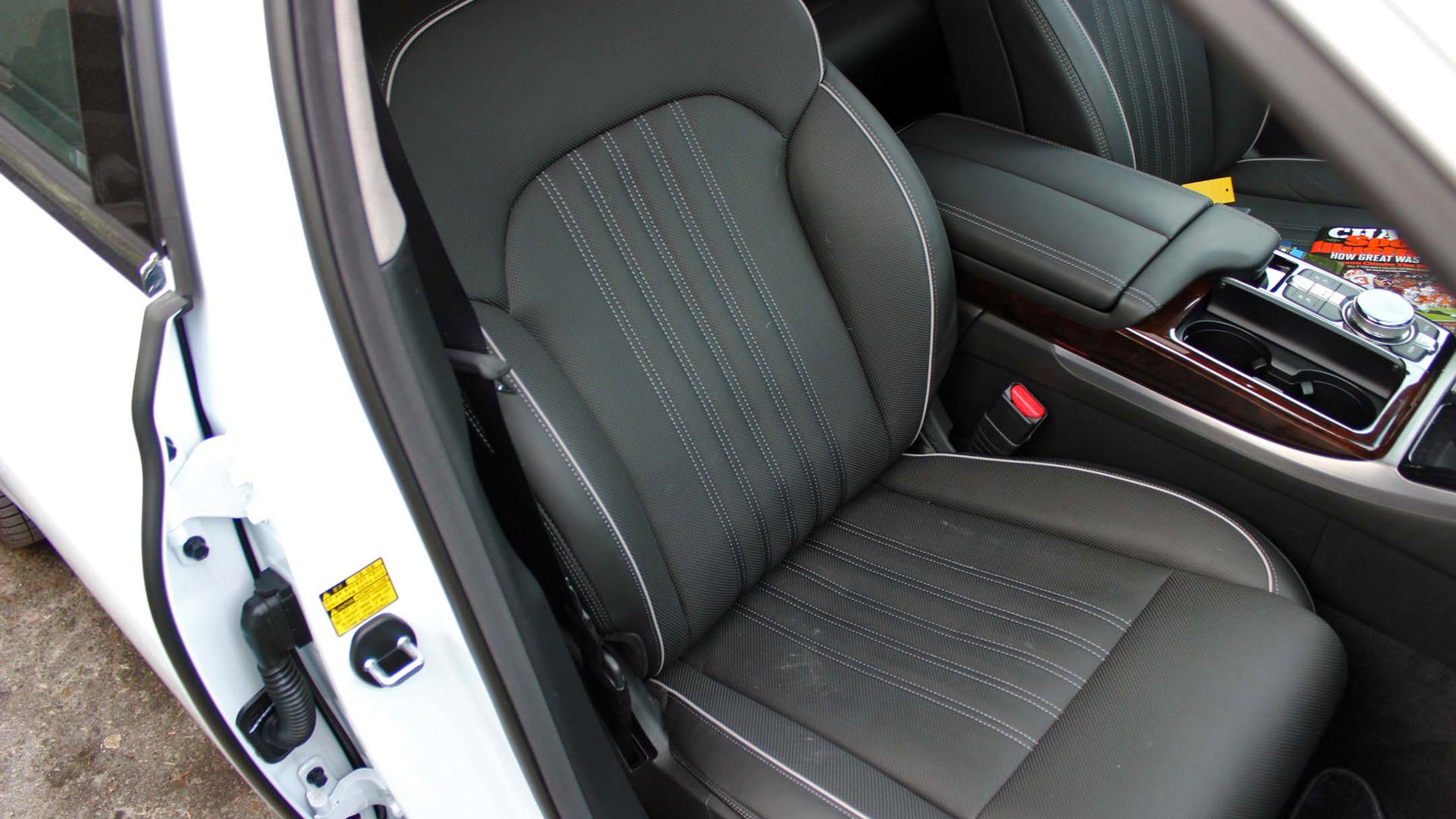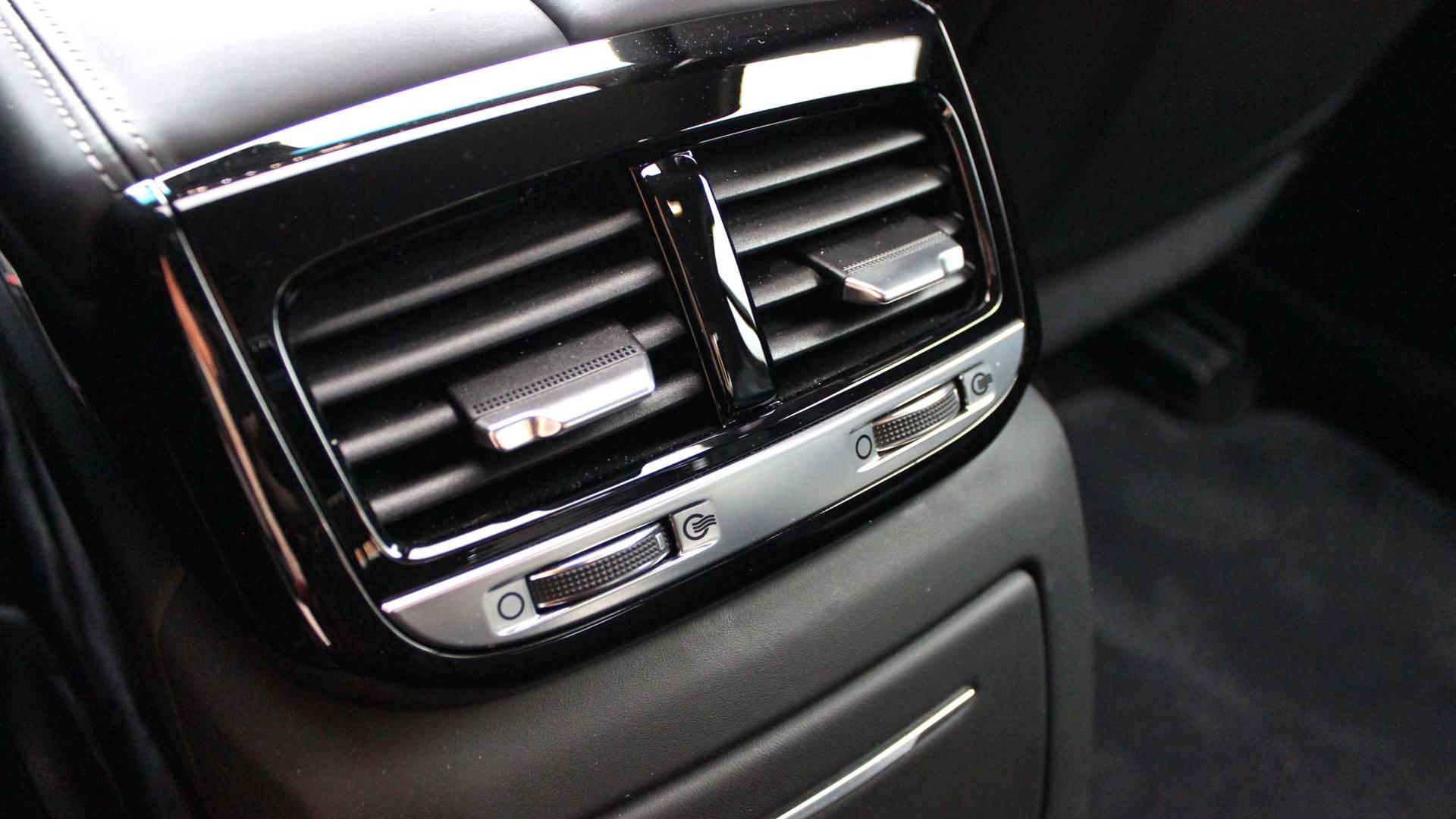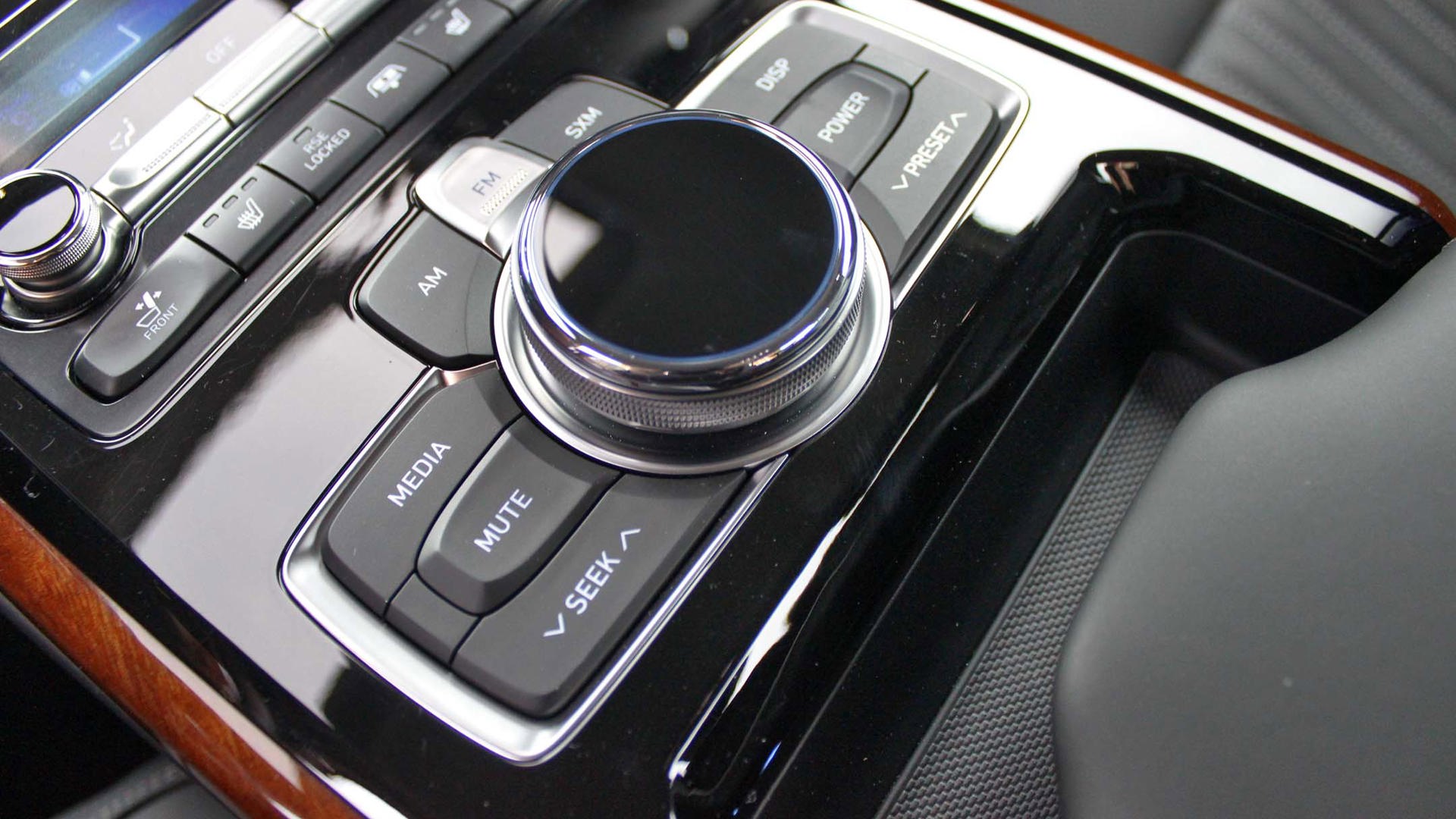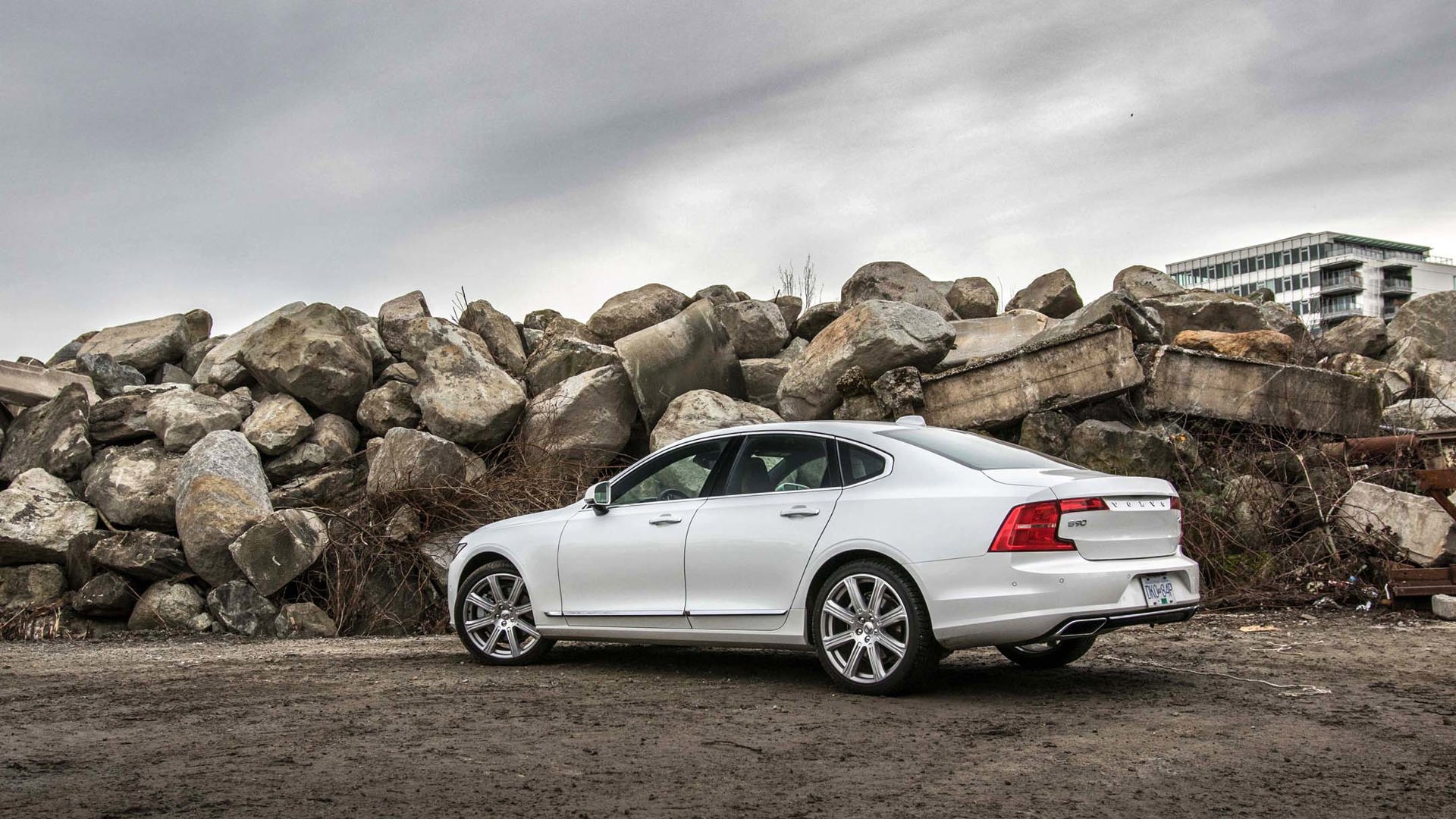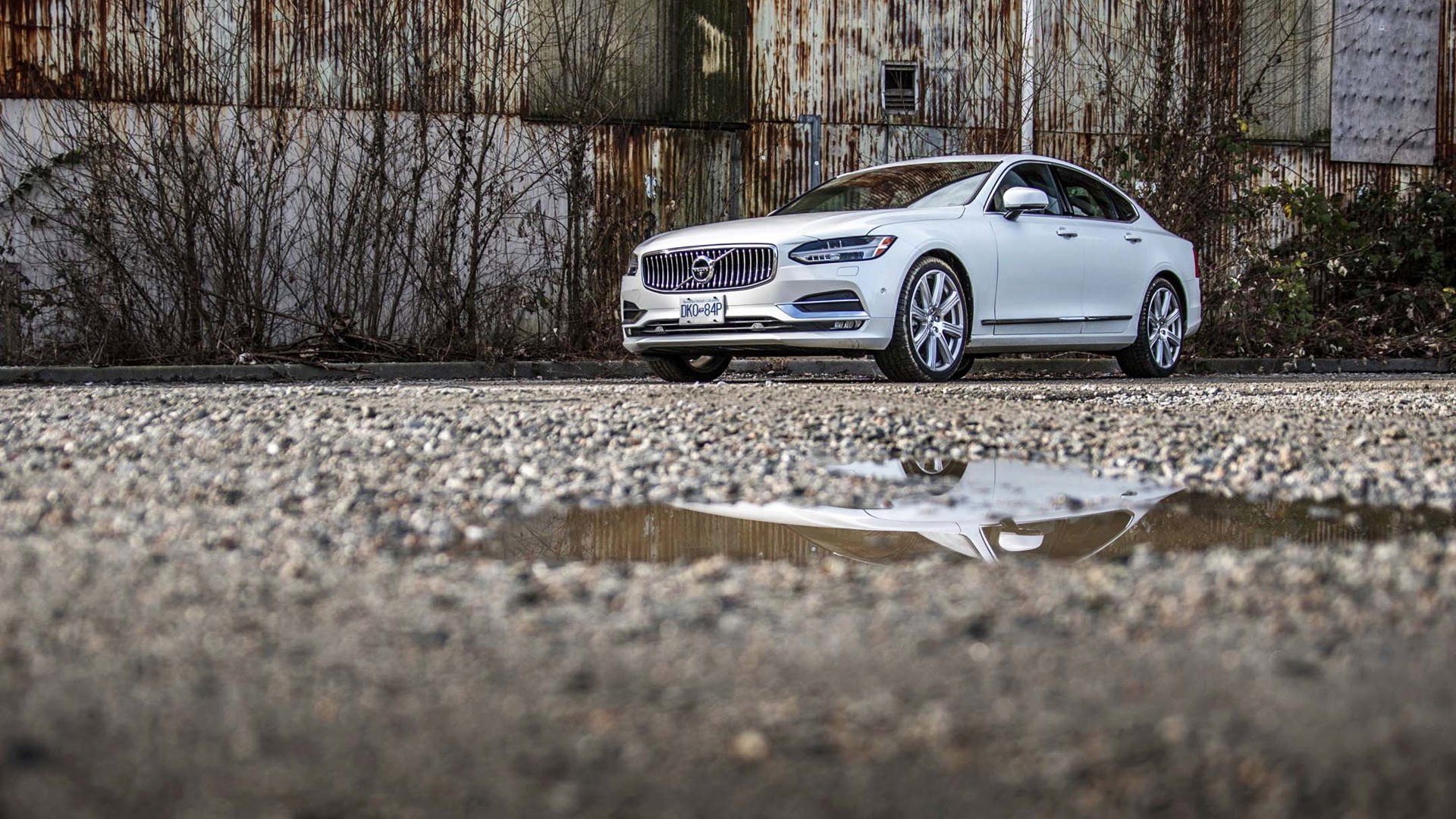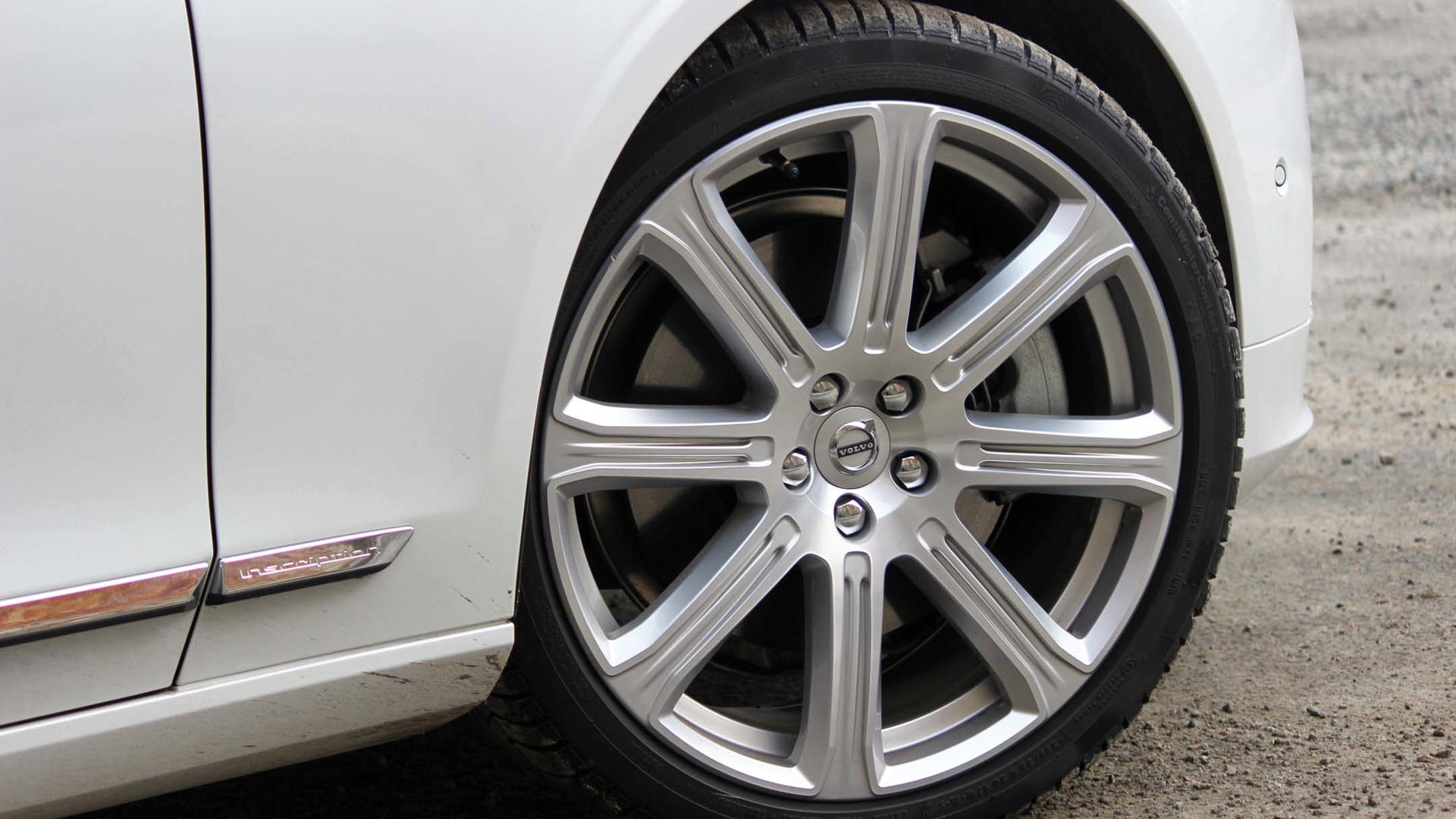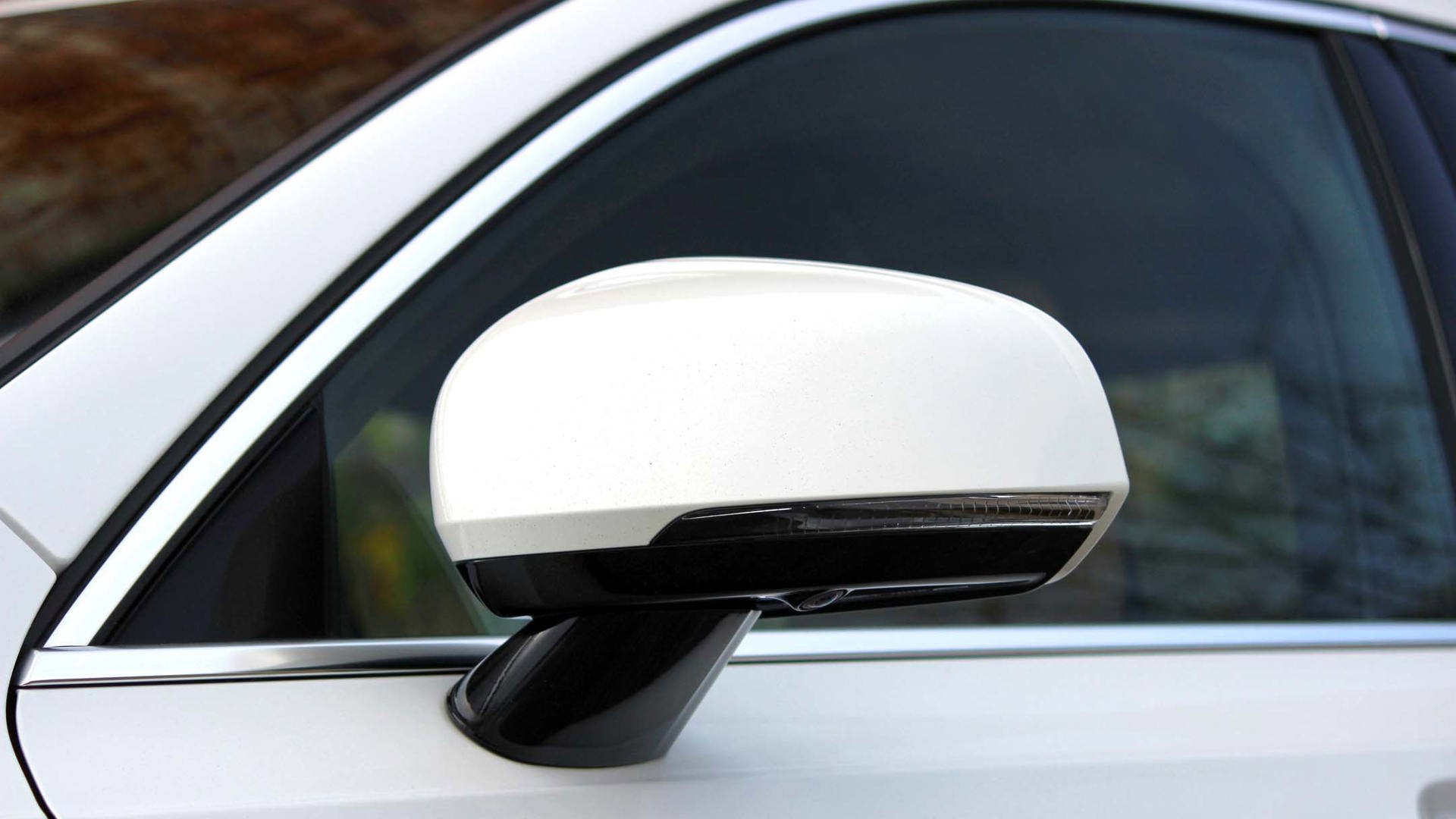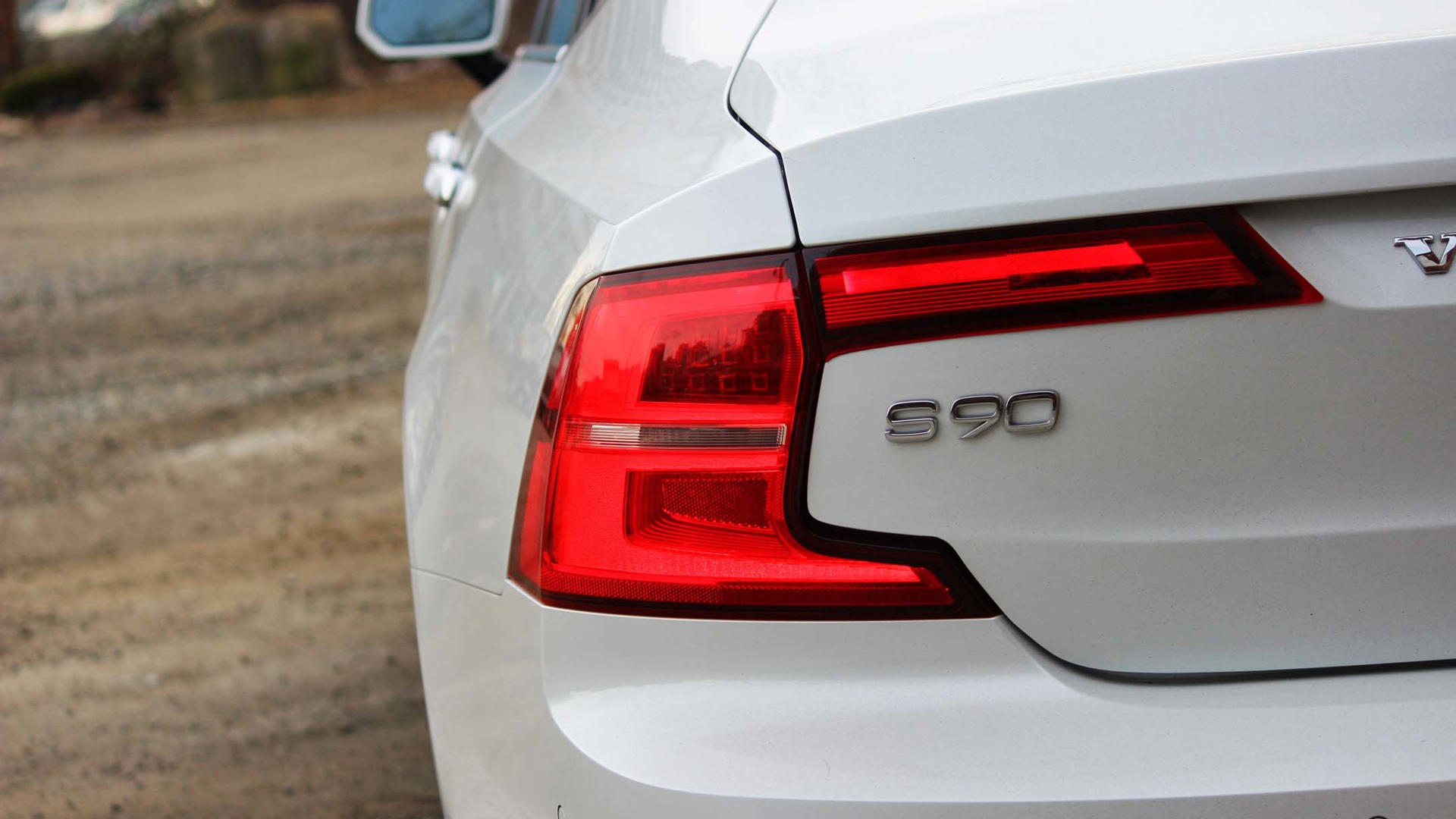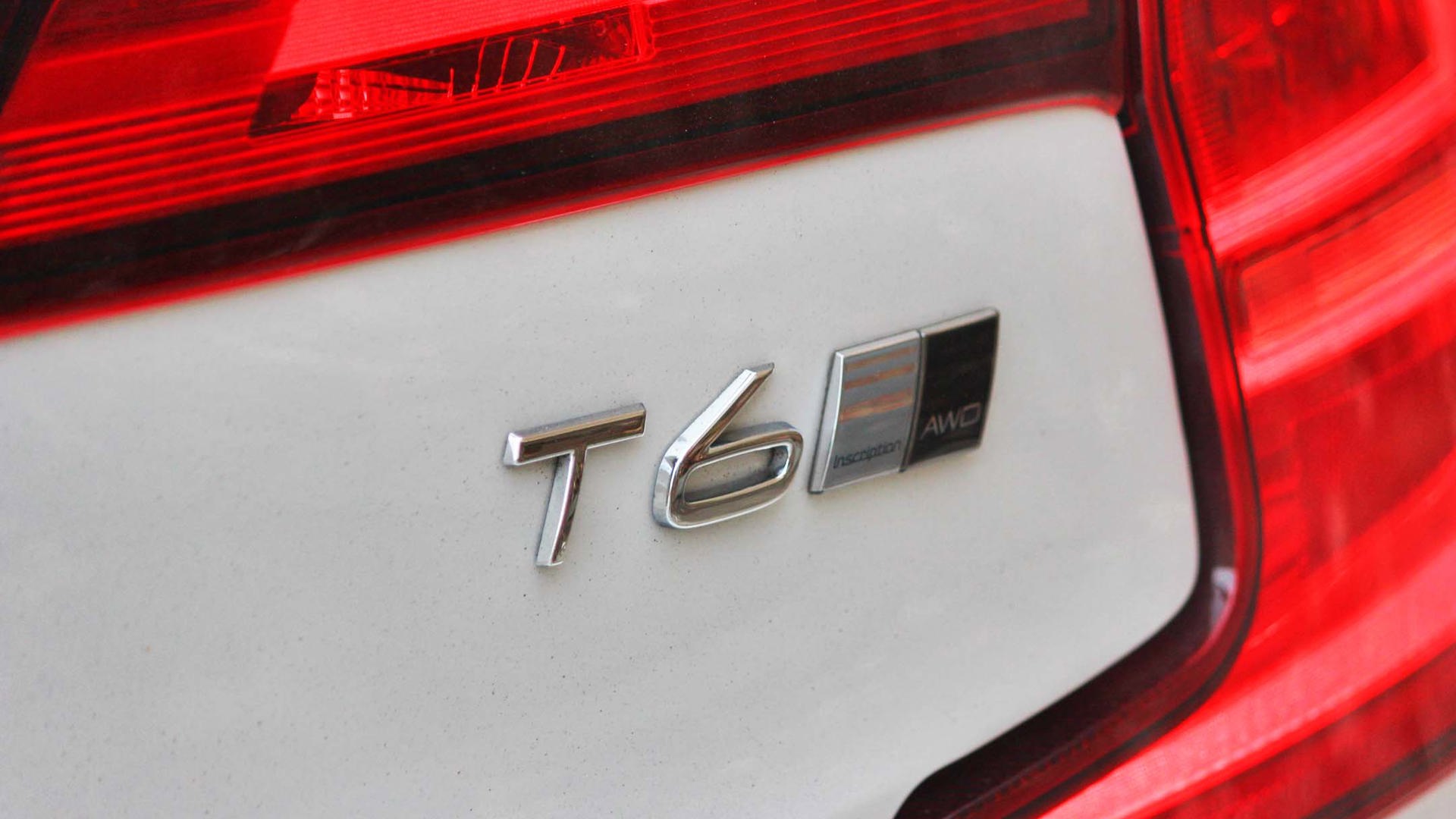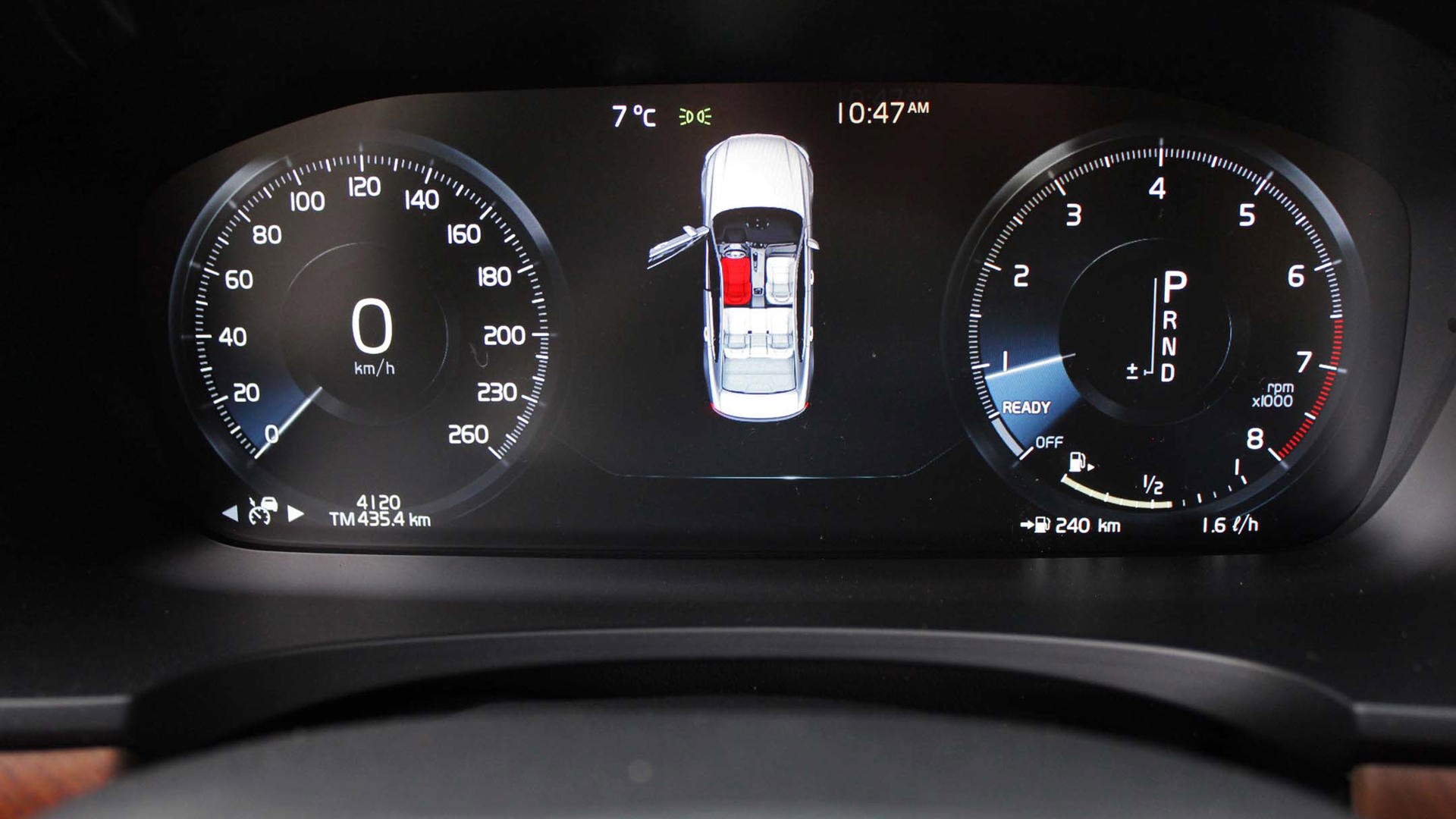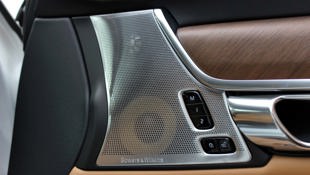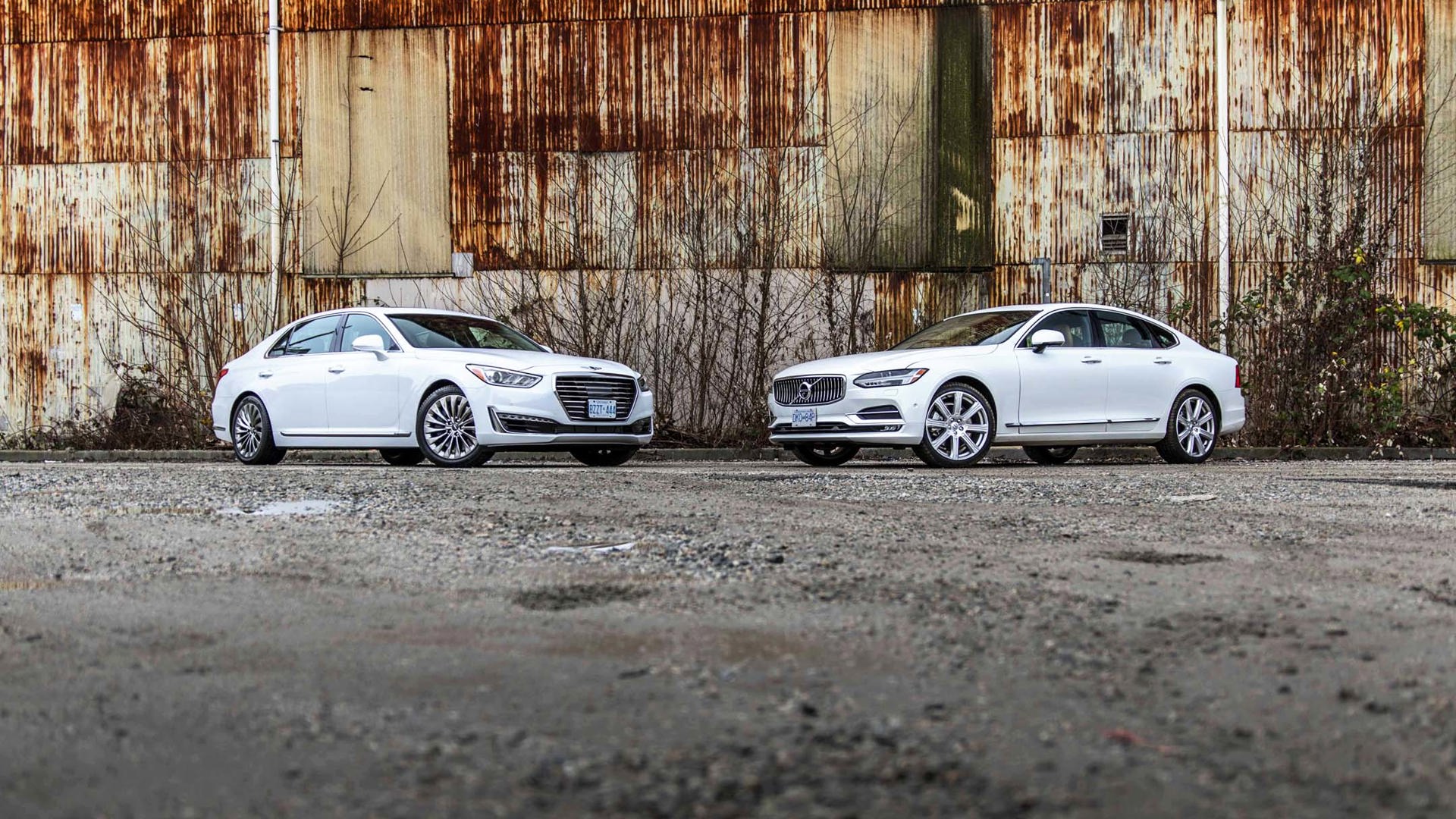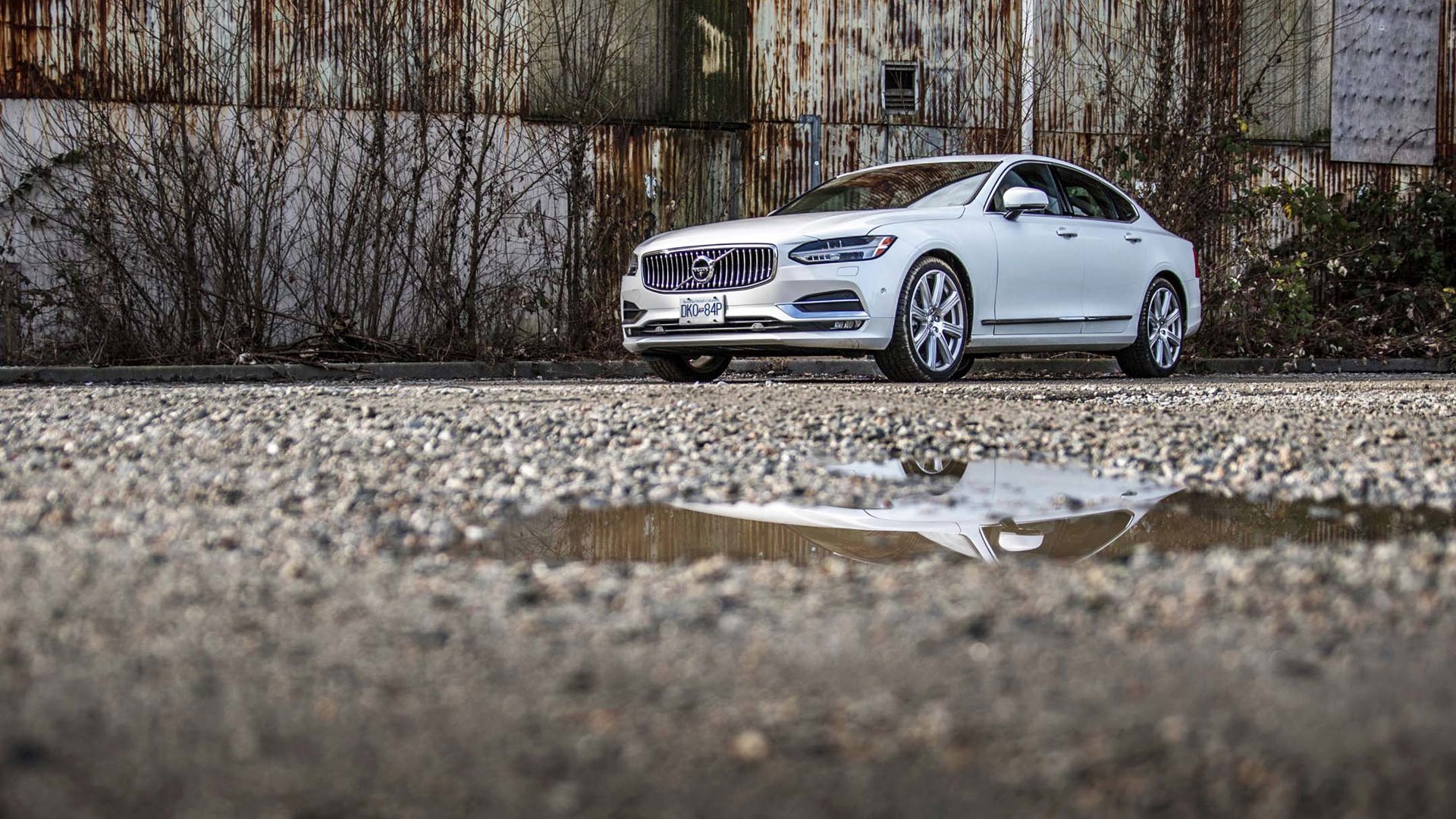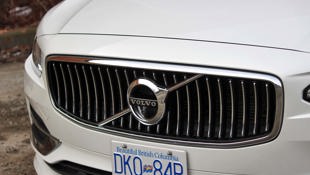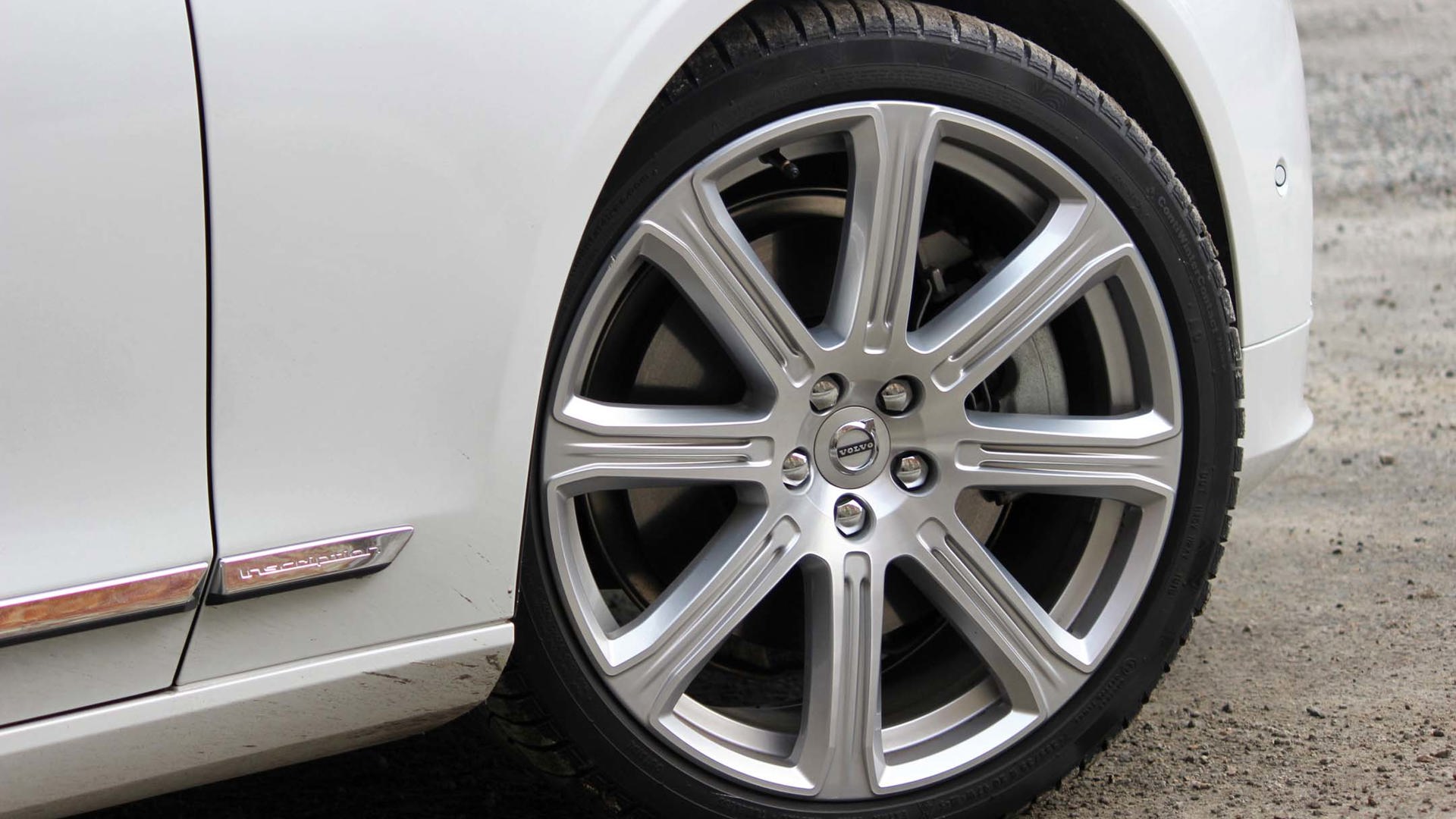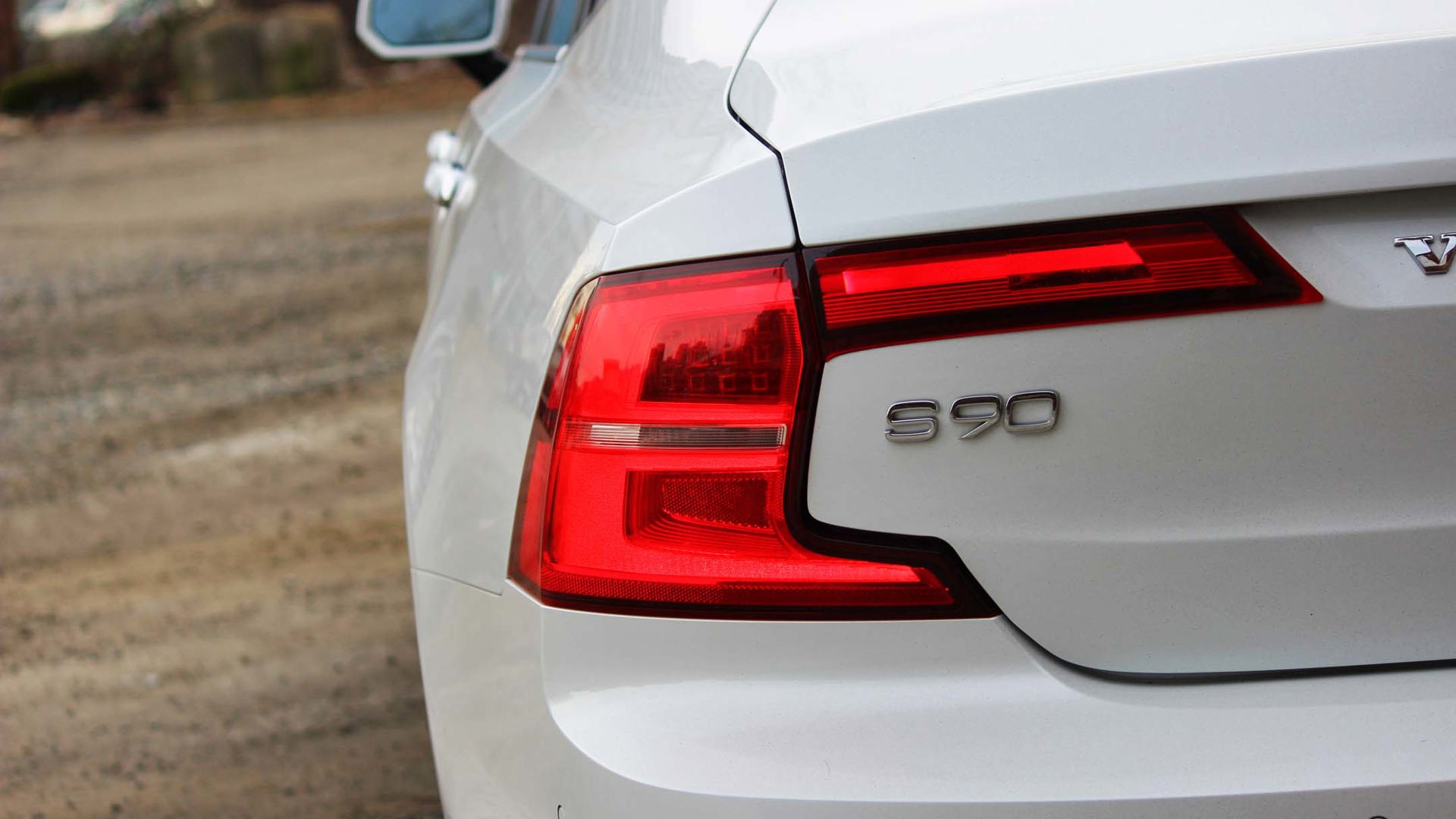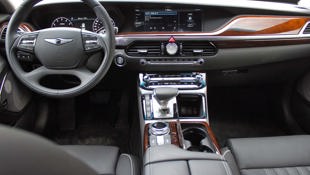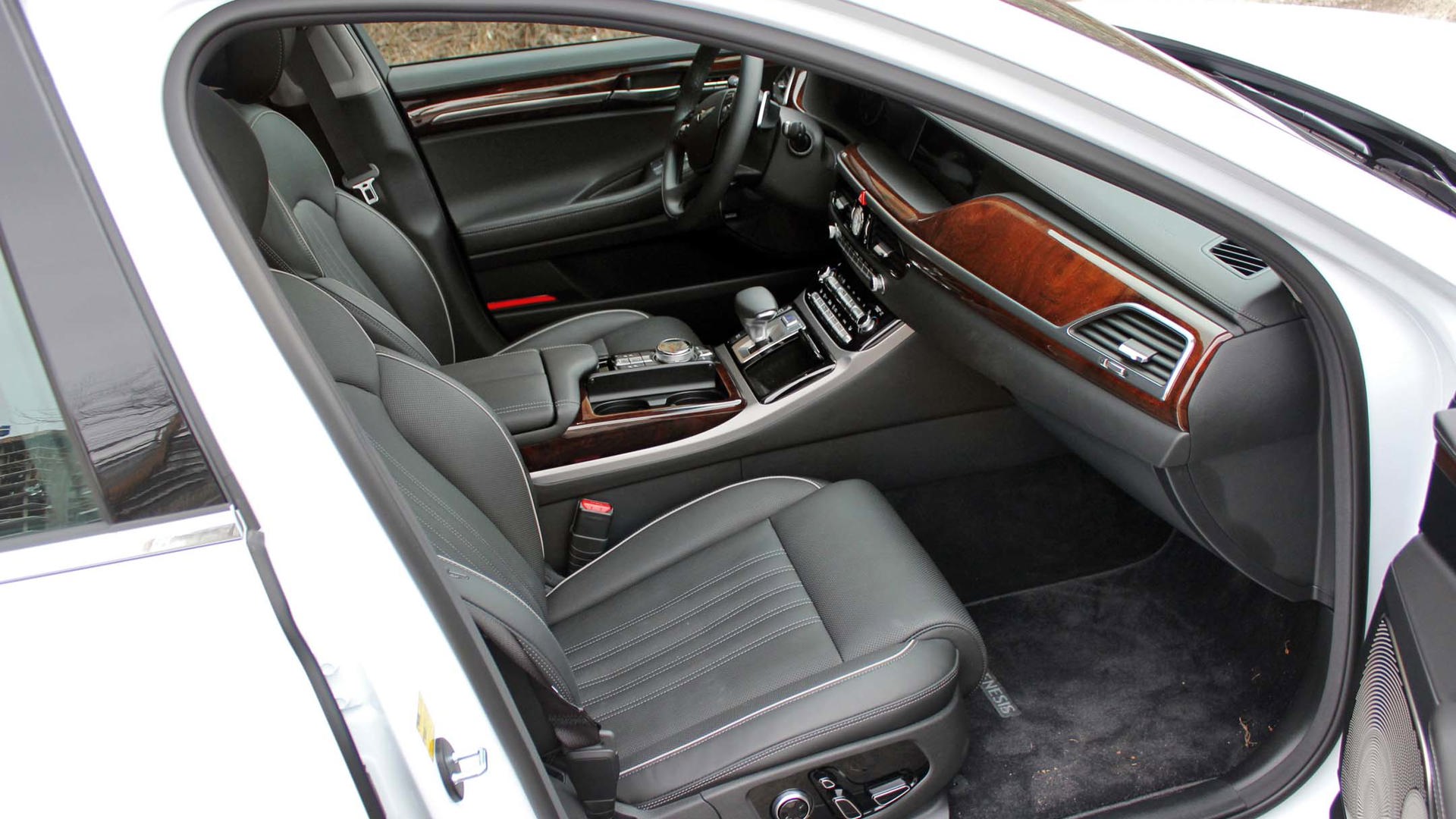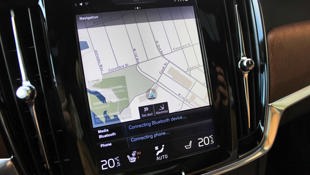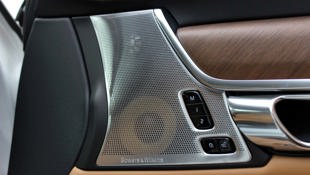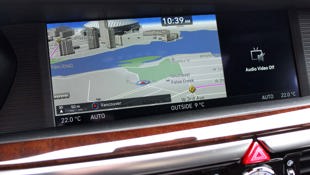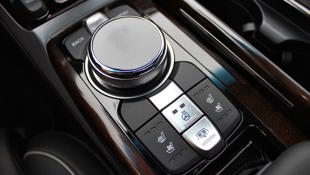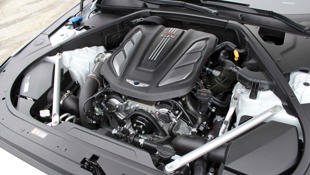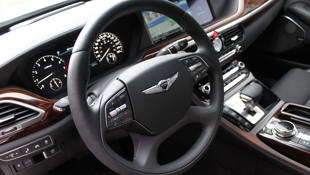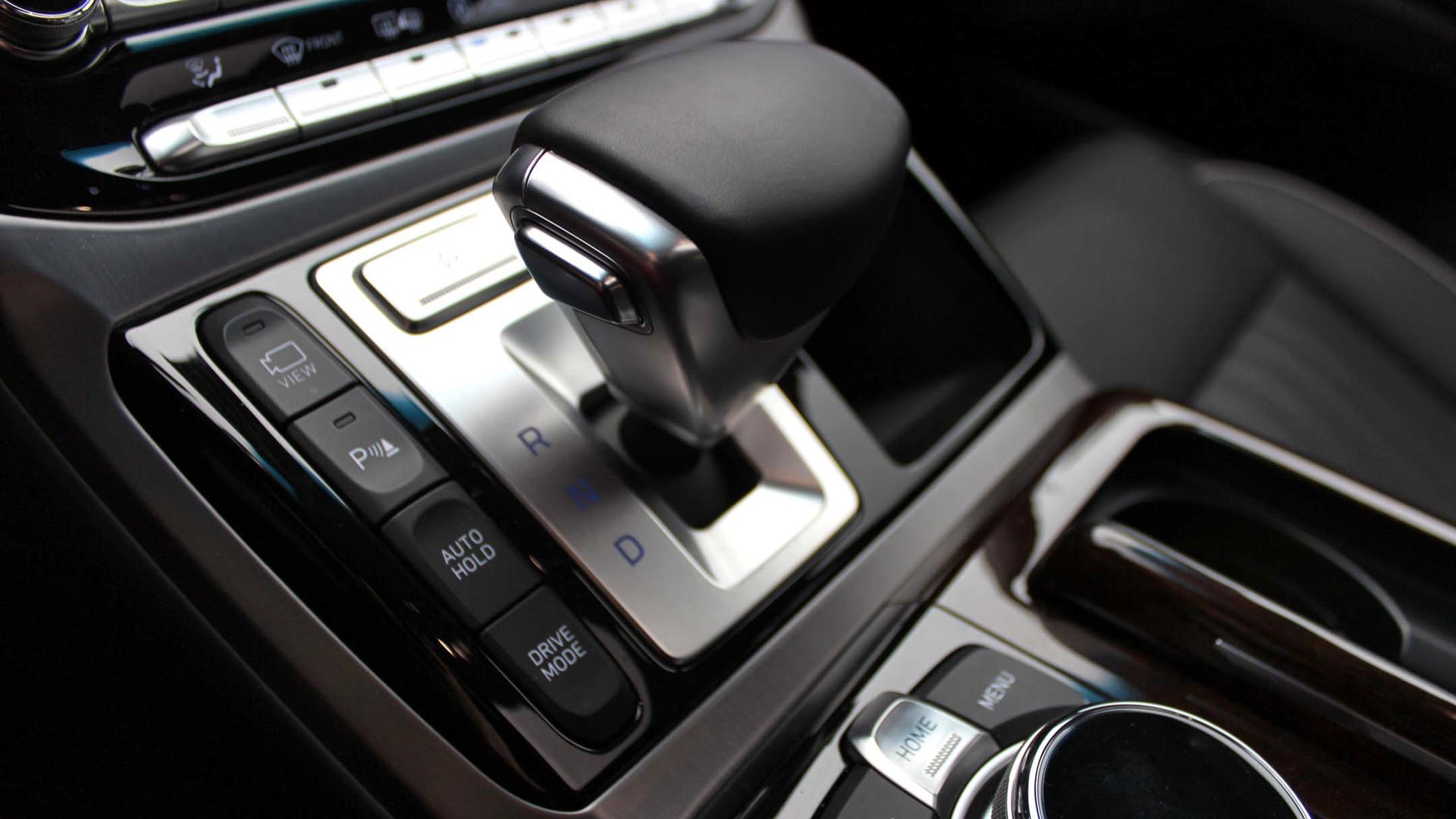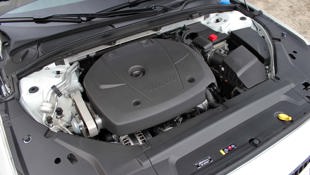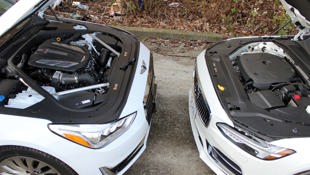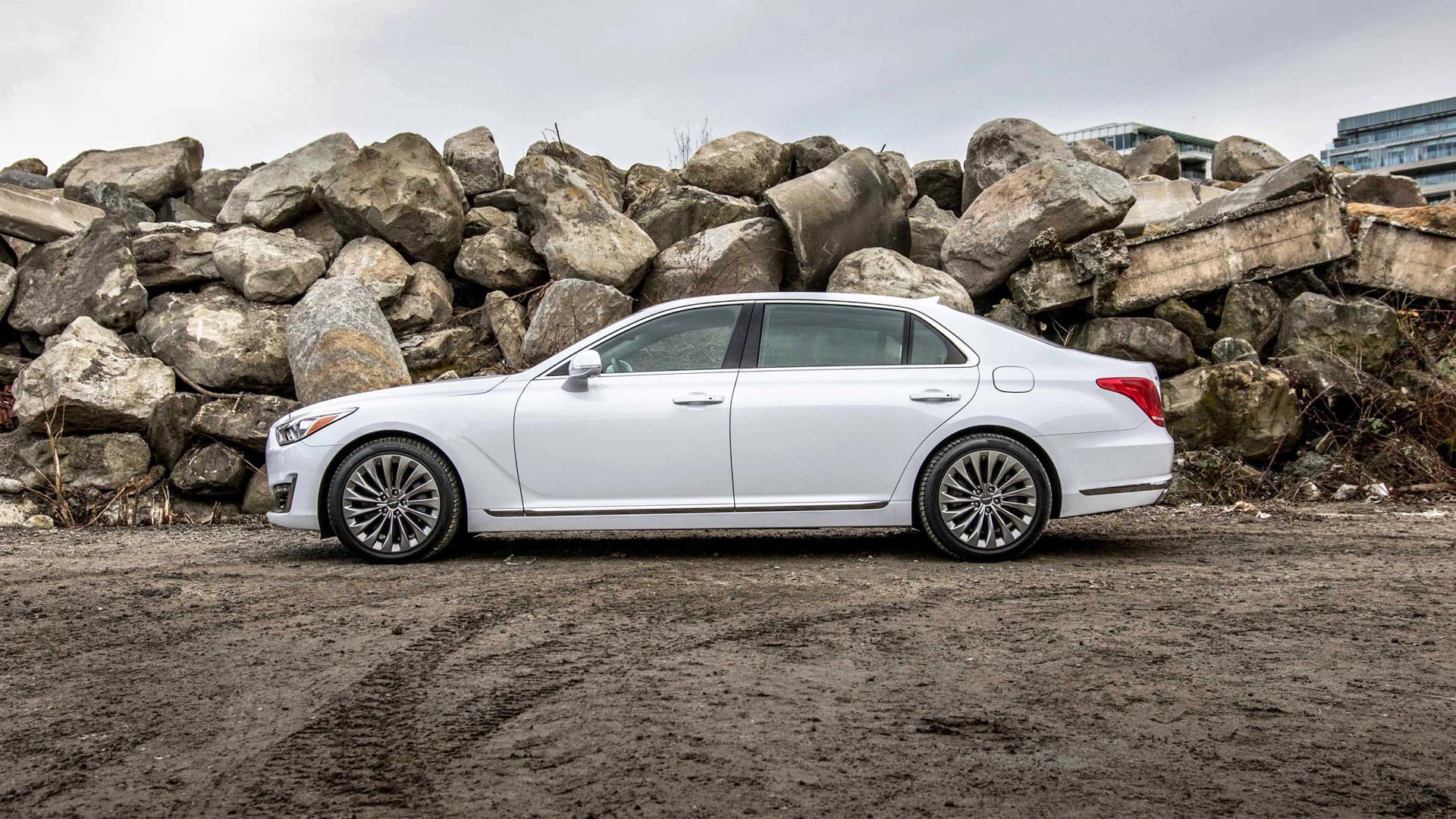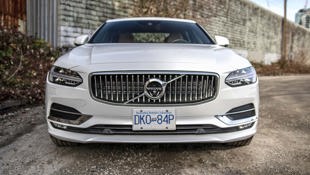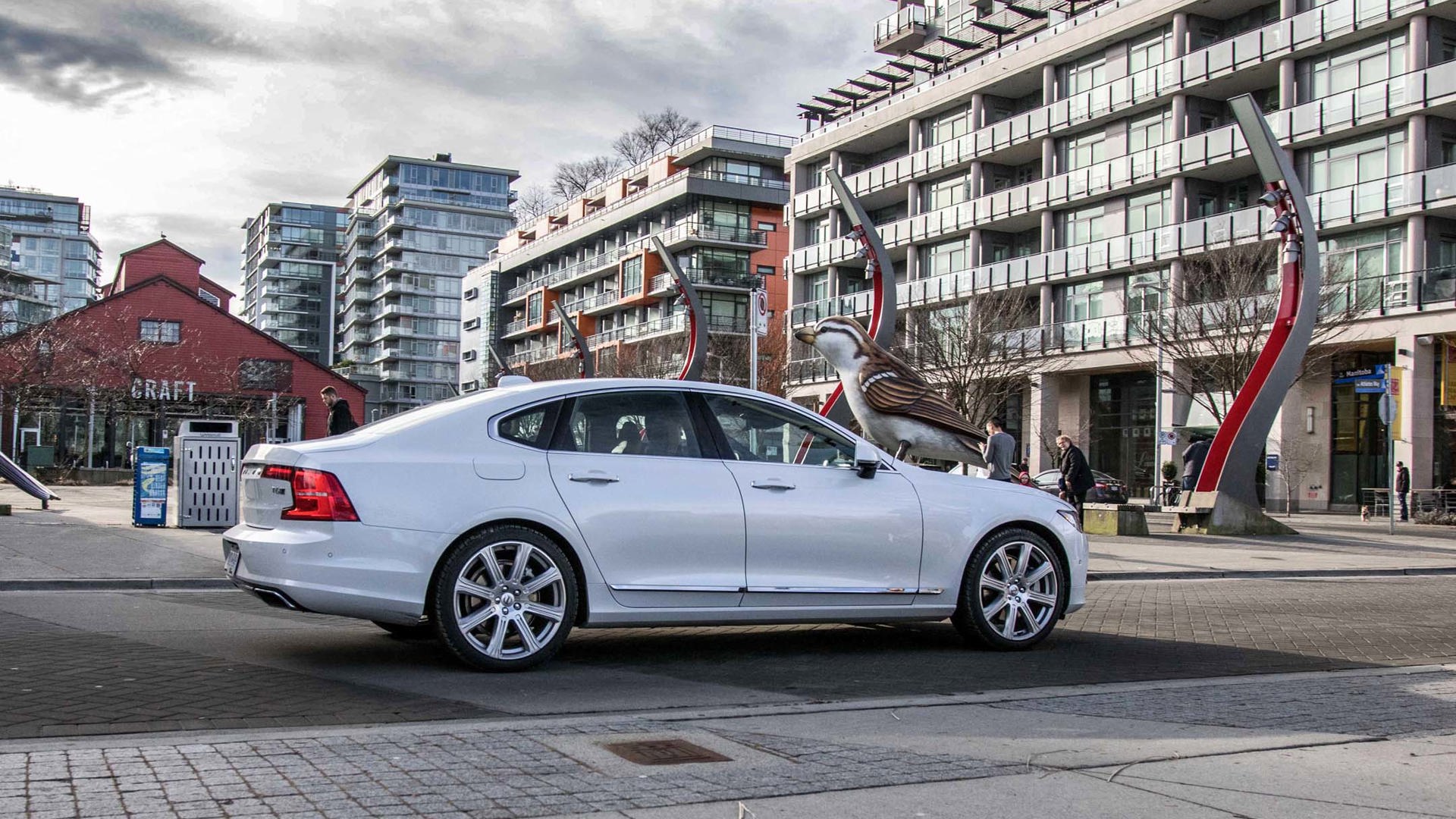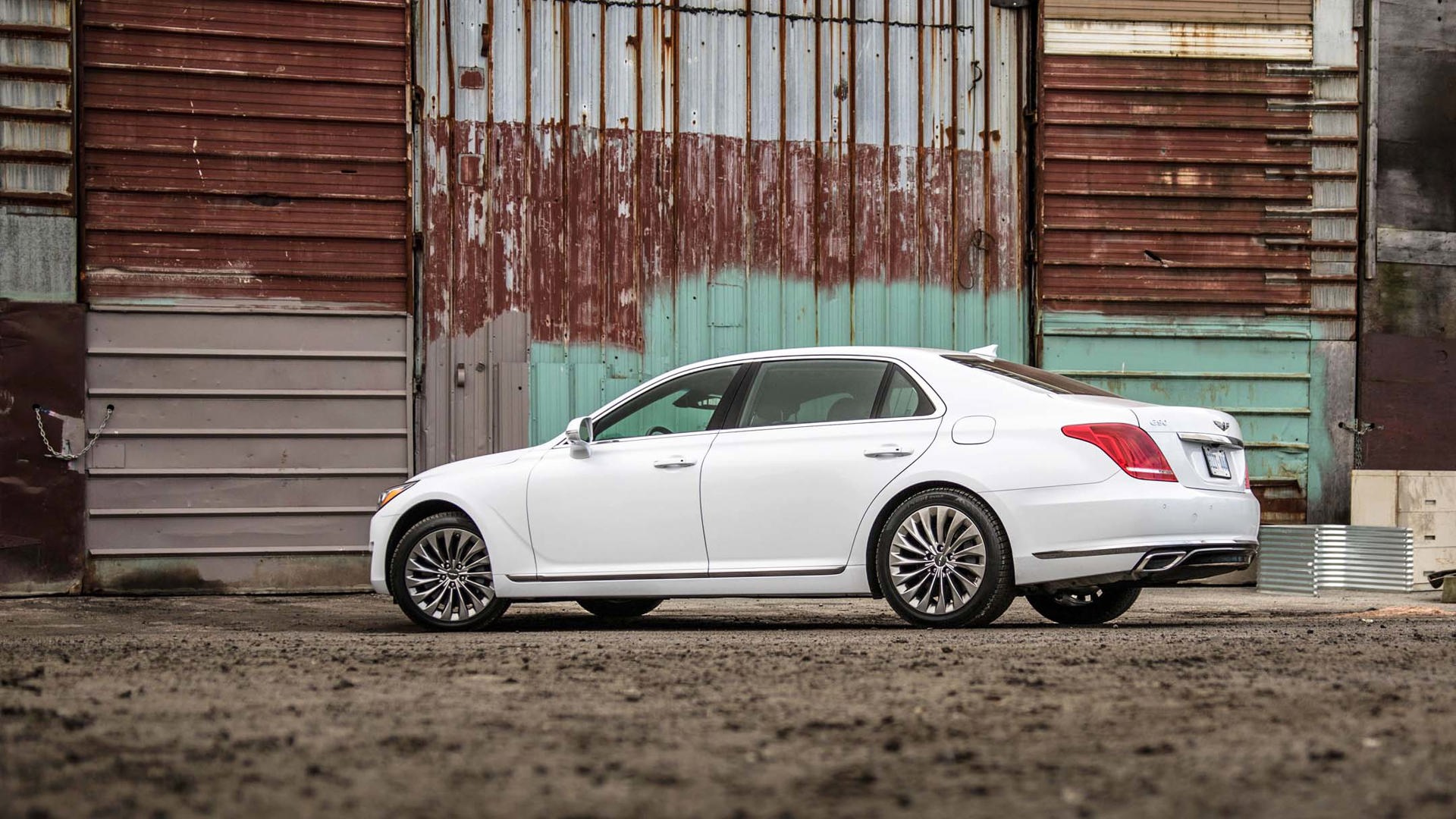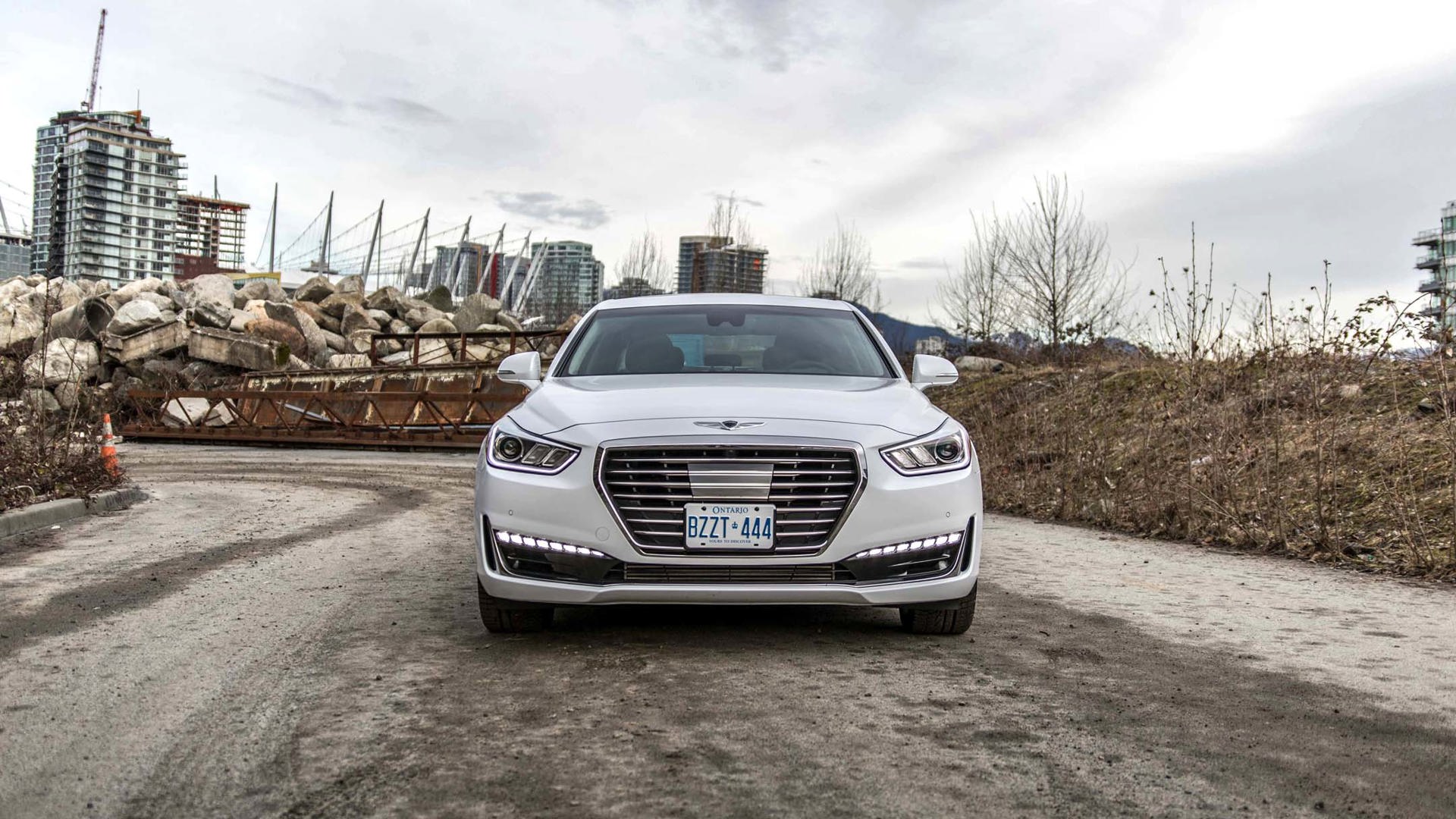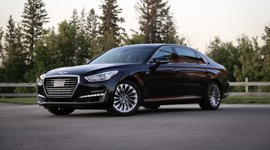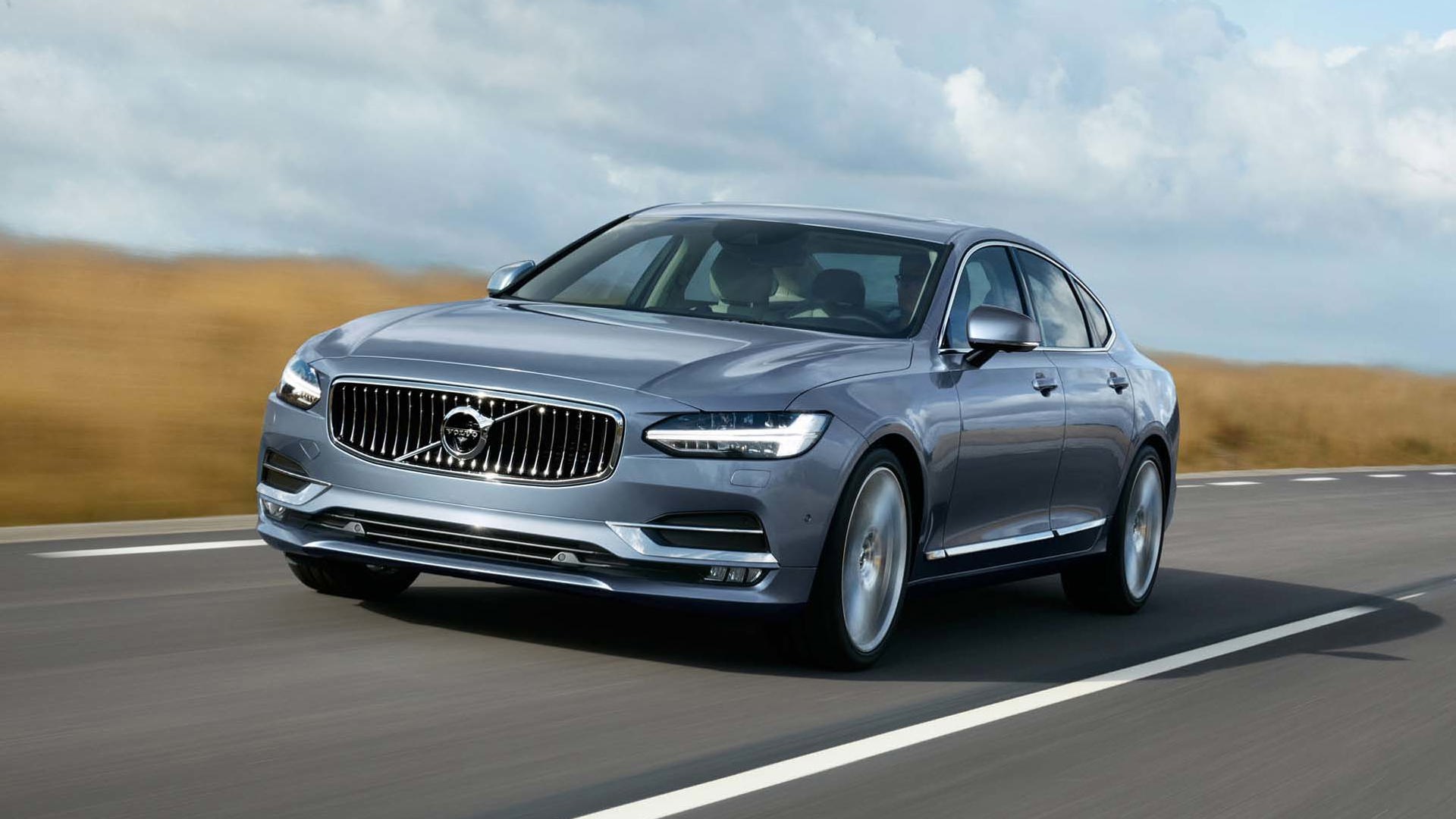Comparison Data
|
2017 Genesis G90 3.3T
|
2017 Volvo S90 T6 Inscription
|
|---|---|
|
Engine Displacement
3.3
|
2.0
|
|
Engine Cylinders
6
|
4
|
|
Peak Horsepower
365 @ 6,000 rpm
|
316 @ 5,700 rpm
|
|
Peak Torque
376 @ 1,300 rpm
|
295 @ 2,200 rpm
|
|
Fuel Economy
13.7/9.7/11.9 L/100 km cty/hwy/cmb
|
10.8/7.6/9.4 L/100 km cty/hwy/cmb
|
|
Cargo Space
453 L
|
396 L
|
|
Base Price
$84,000
|
$63,000
|
|
A/C Tax
$100
|
$100
|
|
Destination Fee
$0
|
$1,395
|
|
Price as Tested
$84,100
|
$75,420
|
|
Optional Equipment
None
|
$10,925 – Convenience Pkg (park assist front and rear) $1,500; Climate package (heated rear seat, steering wheel,) $1,150; Vision pkg (blind spot monitoring, visual park assist) $2,000; Metallic paint $900; heads-up $1,150; 20-inch Alloys $975; Bowers & Wilkins audio $3,250
|
Update (Feb. 14, 2017): Corrected information regarding Genesis home delivery service, as well as presence of lane-keeping assist in the Genesis G90.
Article and photos by Dan Heyman and Brendan McAleer
The ’90s. Grunge music. Bill Clinton. Jurassic Park. Scrunchies. Bright spandex. The arrival of a World Series Championship in Canada. The last time a Canadian team won the Stanley Cup. These are just a few of the origins that come to mind when considering the decade. Yes, like any decade, it had its challenges – war and famine abroad and some racial tensions closer to home – but in the end, one of the biggest achievements in the decade was the Eastern European countries finally reverting back to the artistic, Bohemian and culturally significant entities they were before the Iron Curtain.
Like those events in the ’90s, the two “90s” you see here mark some new beginnings, too.
So, like those events in the ’90s, the two “90s” you see here mark some new beginnings, too; heck, one of their names pretty much means exactly that.
Let’s start with the less obvious: the 2017 Volvo S90. It marks the first time in a while that a Volvo full-size sedan has a platform to call its own; yes, the S90’s immediate predecessor, the S80, technically used the Volvo P2 platform, but that also had to work beneath some Fords, meaning it had to meet restrictions set for more mass-market vehicles. The S90’s Volvo SPA platform also underpins the XC90 SUV, but it was all-new for that and able to work in a slightly more specialized manner. The S90, then, is the next step in the “new Volvo”, a trend that continues with a wagon variant as well as the recently released crossover-ish V90 Cross Country model.
The origin story for the other car in this test, the “we-promise-it’s-not-a-Hyundai” 2017 Genesis G90, is a little more obvious: it’s the first model from what’s technically a brand-new nameplate. Yes, we’ve seen “Genesis” on the back of cars before, but although you could pretty much delete every Hyundai emblem on the Genesis sedan and its Coupe variant if you wanted, they were sold in Hyundai dealers along the Elantras, Sonatas and Santa Fes the brand’s better known for.
While there’s still no dedicated Genesis dealer network, the vehicles will get their own designated spots in US Hyundai dealers (not all Hyundai dealers, mind) and will be available in Canada only as part of a home delivery network. Still, Genesis Motors is now its own entity, and the arrival of the smaller G80, upcoming G70 compact and probably two SUVs/crossovers soon means it will have a line-up to justify its existence as a bona fide brand unto itself.
Aside for their individual origin stories, both the S90 and G90 combine to form an origin of an entirely different type, that being the trend of luxury manufacturers going away from big, fuel-thirsty V8s for their flagship sedans. You can still get a G90 with a V8 if you like – ours has a twin-turbo V6 – but the Volvo gets the single engine choice. It’s not even a V6, but a turbo- and super-charged inline four. While Acura has used V6s in its RL-line for a long time, Audi, Mercedes, BMW, Lexus and more have always relied on V8 power for their flagships. In this day of tightening emissions restrictions and fuel-consciousness, that simply will no longer do.
Brendan says:
As Dan points out, the ’90s were a time of alternative tastes. Thus, it’s fitting that these two machines provide an outside-the-mainstream option to standard fare from Europe and Japan. Volvo’s hardly the upstart in the segment that Hyundai’s now-standalone luxury brand is, but it fights the same battle: why meddle with the unknown when you can simply march down to Lexus, BMW, or Mercedes-Benz, and be assured of finding a vehicle with either proven resale or unassailable brand cachet?
However, human beings like to have choice (we’d all drive Corollas, otherwise), and both Volvo and Genesis offer some appeal right out of the gate by not being the same-old same-old. Which, then, achieves Nirvana, and which is only Semisonic?
Styling
Brendan says:
While nearly everyone references long-lived boxy stalwarts like the 240 sedan when discussing Volvo’s modern efforts, the Scandinavians have been building great-looking cars for decades. The second-generation C70 coupe, for instance, has aged like Ingrid Bergman, and the V70R continues to be one of the hottest-looking hot station wagons we ever got on this side of the pond.
The new S90 is thus not a break with tradition, but an extension of it. Swedish design has been touted for ages for placing an emphasis on cleanliness of form and a cohesive message, and that’s what we have here. Forget the Ikea bookcase, think Arne Jacobsen.
From the expected heritage grille elements to the signature LED headlight accents, the S90 shows a handsome, but not overwrought face to the world. This in itself is remarkable in a world where every single press release begins with, “New, more aggressive...”. The S90 is not aggressive, though it is chiselled. If anything, it just about borders on too-reserved.
The Genesis G90, on the other hand, doesn’t just border on reserved anonymity, but crosses those borders with a full-scale invasion. This is the kind of car that would be ideal for robbing banks, as half the bystanders would claim it as a Chrysler 300, and the other half as some kind of Bentley. I’m not suggesting you factor larceny into footing the lease payments here – but you could.
In one sense, that’s a likeable attribute in a large sedan that touts value as the main reason for buying. Volvo wants you to consider the S90 because it’s sleeker than the Germans, Genesis is betting you’re mostly concerned by what’s on the inside.
Having said that, I think the design team could have spent more than what looks to be about five minutes coming up with unique badges. Further, the G90’s grille is about a third too large. Blend in, if you’re aiming to blend in. The Volvo aims to be pretty, and is. Point to the Scandinavians.
Comfort
Dan says:
Right off the bat, you knew the G90’s back seats were going to take the cake here. There is just so, so much room that the rear doors are massive to the point they look like something off an extended-wheelbase, quasai-limo livery sedan that you might grab at the airport. When you’re offering up 960 mm of rear legroom (though it feels a whole lot more) and 965 mm of rear headroom, the doors are bound to be big. Not to mention that we imagine many of these to be chauffeur-driven – especially in their home country of South Korea – meaning ease of entrance and egress for the rear passengers is paramount. Which is also why they’re allowed to operate the front passenger seat if they want their own legroom, as well as the infotainment system via a joystick mounted into the centre armrest that mimics the item up front. There is no rear entertainment system, however, which is odd considering the environs. The seats themselves are incredibly cushy, and while Volvo has kind of had the seat market on lockdown for quite some time, now, the items in the G90 win the laurels for this test thanks to their padding and support, and that’s without the optional rear-seat package that adds reclining seats that are more airliner-like in their operation than they are car-like.
Neither of our cars had reclining or folding rear seats, however; you have to think most that are buying the G90 especially are planning on using those, so why fold them away? I guess the lack of folding rear seats in the S90 is a little tougher to forgive, but both cars do feature pass-through doors so you aren’t entirely out of luck with either car when it comes packing skis and the like.
Of course, it’s not that the Volvo is bad in the back, it’s just that the Genesis makes the S90’s rear door openings look like they belong on a compact sedan. Once back there, however, you get a none-too-shabby (when compared to most other cars, that is) 911 mm of legroom and at 960 mm, almost as much rear headroom as the G90.
The front seats in the Volvo don’t disappoint, either; nor should they, as Volvos are known for quality chairs and have been for quite some time. The leather is such that it feels like a nice leather glove as soon as your slide yourself into one of these, which we love.
I wasn’t quite as enamoured with the way the adjustable thigh support on the driver’s seat goes about its business. It’s nice to have, but the chasm left between the thigh cushion and the rest of the bottom seat cushion can really be felt. I couldn’t shake the feeling that I was sitting in a chair that was missing a piece; I ended up pretty much closing the thigh extension all the way, which kind of defeats the purpose.
The G90’s items don’t have that feature, but they are supportive and look the part, with their ventilated surface and contrasting stitching colour. They also are adjustable 22 ways – twenty-two! – thanks to nifty additions like adjustable side bolsters and four-way lumbar support. It’s nice to see that Genesis didn’t forget the driver when it came time to engineer the interior. Both the front- and rear-passenger seats are heated and cooled to three levels, while the rear passengers – this should come as no surprise – get their own climate controls.
They do in the S90, too, although their seats are heated only. Still, once through the slightly smaller door opening, most save for the tallest passengers should have no problem finding some comfort back there.
Tech
Dan says:
S90 passengers won’t quite have the tech to play with as they would in the G90, however.
It’s strange; when I first sat in the Volvo after I did the Genesis I remember thinking that it was too bad that while the newcomer is well-equipped, the car from the more veteran brand just pipped it. The Genesis’ steering wheel is heated to two levels, which I though was pretty great, until I stepped into the Volvo, whose wheel can be heated three ways. Small potatoes? Maybe, but then you look at the iPad-like infotainment interface (it’s an all-touch affair; the G90’s system is operated by a centralized joystick/button), the digital gauge cluster (standard on the Inscription trim; other S90s get a more traditional cluster), and the swanky Bowers and Wilkins sound and you’re like, “Yeah. This is where it’s at.”
Look a little closer, however, and the Genesis really starts to stake a claim to the tech crown. For starters, the central 12.3-inch widescreen display is crystal clear and certifiably awesome in the graphics department – the option to have 3D-rendered buildings is detailed to the point you think you’re looking at an actual CAD model – easy to navigate and houses one of the best back-up cams in the biz. Plus, since there’s no touch involved, the screen doesn’t get doused in grease spots. The Volvo? Give it ten minutes, and that screen – plus the surrounding dust-magnet piano black finish – will look like an iPad regularly used by three-year-olds.
Oh, and that B & W sound we talked about regarding the Volvo? It’s good, but the 17-speaker Lexicon set-up in the Genesis is clearer, and the way the door tweeters are subtly blended into the trim is oh-so-cool to behold. Once you realize they’re there, of course.
It’s not to say the Volvo’s system is bad – once you learn to navigate the interface, which is a little convoluted at the outset. You have to swipe left and right to access many of the features as there isn’t really one single home screen, per se. The screen itself is properly responsive, with nice, big buttons though the whole shebang is a little text-heavy.
On the infotainment front, then, I’m giving the nod to the G90. When it comes to driver aids, they’re both on-point. The G90, for example, has a lane-keep assist system that vibrates the wheel when you depart, and the visual blind-spot warnings are displayed on the HUD. Both have adaptive cruise and passive lane-departure warning systems followed by active lane-keep assist. The adaptive cruise on both cars are of special note, as both system’s were easy-to-operate and worked subtly in the background so as not to upset your ride too much when active.
Our S90 Inscription version adds another party trick, and that’s the ability to park automatically in both a perpendicular and parallel manner. The G90 has no such thing, but as we mentioned before, it has a sharper back-up display that provides front, back and side views. You have this option in the S90, too, but, it takes a little navigating through the touchscreen to activate it. The G90? A couple of simple button presses is all it takes. Both cars, however, provide swept-path indicators on the top-down view, which is great to have for long cars like this. I did find, however, that the S90’s auto park job would often leave me about six inches further from the curb than I’d normally like. Good the power folding mirrors do so automatically when you blip the lock button, then.
This is a tough one to call. It’s very much like the driving impressions: if being coddled and spending your drive time dealing more with infotainment as opposed the dynamics on offer, the Genesis is the winner. If you want more of a mix, however – plus more of a slant towards autonomous driving – the Volvo would work well.
Having said that, it’s really hard to ignore the sumptuous luxury presented by the G90. And at this price level, that really does matter. Having said that, when you consider the Genesis’ limo-like luxury chops, the like this starts to matter more. Mercedes uses GPS in its S-Class to help you drive more efficiently, the 7 Series can park itself – without even having a driver inside it – in some markets. Tech really does matter here – that’s tech across the board, not simply in one aspect – and then when you take into account the driver aids, the S90 wins out.
Brendan says:
The more traditional the buyer, the more they’ll like the G90’s button-heavy setup. Also, why is blind-spot monitoring an option in the Volvo? Seems like they could take a page out of Toyota’s playbook and make all safety features standard.
Performance and Handling
Brendan says:
Because a large sedan is meant to be both driven by an owner and for an owner (by a chauffeur), Dan and I decided to switch up our standard back to back hot seat swapping with a little livery service around downtown Vancouver. I played driver, because an Irish chauffeur just seemed the Downton Abbey thing to do.
First, the Genesis, which was built to ferry around dignitaries. Formerly the Equus, this is a chariot that is meant to be enjoyed not from the front, but from the back – Lord Dan of Heyman will shortly relay how well it performs there. However, the G90 is not without its charms.
First of these is the 3.3L twin-turbo V6, which makes 365 hp at 6,000 rpm, and a far-more-important 376 lb-ft from just 1,300 rpm. This is a smooth and substantial engine, whispery quiet and unstressed. Other twin-turbo V6s offer considerably more shove – think of the Infiniti Q60 Red Sport and its 400 galloping horses – but the G90 delivers a near-effortless acceleration. There is a V8 version as well, with further options and a more genteel engine note, but the G90’s standard powerplant makes a good argument against the need for eight cylinders. You simply don’t hear it, and the eight-speed automatic transmission does a good job of fading into the background as well.
Sure, there’s a Sport mode, but I can’t imagine anybody actually using it. The G90 is simply enormous, and while it’s not exactly ponderous to drive, the takeaway experience is of piloting a large and substantial automobile.
Over at Volvo, there’s another argument being made against the de rigeur V8s of the luxury class market, and it’s a little more unusual. The S90’s only engine offering is a 2.0L twin-charged four-cylinder engine, which makes 316 hp at 5,700 rpm and 295 lb-ft at 2,200.
Twin-charging involves using both turbo- and super-charging to maximize the efficiency of forced induction while muting its foibles. Supercharging, for instance, offers excellent throttle response, but causes parasitic power loss the higher the revs go. Turbocharging works great at high revs, but can be laggy at the low end. Combining them adds complexity, but allows for a more flexible engine.
To its credit, all you hear from the S90’s proletarian four-banger is the sound of boost. It’s not particularly loud from inside the car, but when you do roll with the windows down, all you hear is whizz and whoosh, rather than the uncouth thrum of a four you can get elsewhere. It’s not exactly packed with character, but it’s not a complete turnoff.
And, as a benefit, losing cylinders has lightened the S90, giving it a fairly dynamic on-road presence. It’s far lighter on its feet than the bulky G90, though the latter’s engine reacts more quickly. Thing is: if you were looking for dynamic supremacy, wouldn’t you be over at BMW checking out the new 5 Series?
The G90 does a great job at feeling like a bargain version of a Lexus LS400, while the S90 loses a few points for the way it doesn’t quite match BMW in sportiness, but also occasionally fails to soak up bumps with total poise (blame the optional 20-inch alloys, perhaps). The Korean won’t outrun the Swede, but that’s not really the point here.
Dan says:
You have to hand it to Volvo for this powertrain. It seems that it was only yesterday that a twin-charger engine like this was reserved for manic rally cars and racers. Sure, with the advent of hybrid technologies, multi-faceted motive force is becoming more of the norm. For folks that still feel the need for a more traditional powertrain, however, the Volvo offers a very tantalizing option.
The Genesis, of course, is a little more traditional but my if it isn’t one of the best uses of more-traditional technology in recent memory. For all its weight and doodads, the Genesis gets up and moving in a hurry, the turbos exhibiting very little lag – and again, a lot of what can be felt can be attributed to the weight – and firing you down the boulevard. The pickup is such that it seems Genesis engineers didn’t bother offering a more aggressive throttle setting when in Sport mode, which affect the steering and suspension. Thing is, even with the latter two aspects, I didn’t find the change to be so marked. Yes, it’s a little less wallowy over bumps and body roll is reduced slightly when in Sport, but you’ve really got to focus to feel it and I didn’t find much difference in any of the three steering settings at all.
The Volvo, on the other hand, provides very different feedback as you play with the steering and throttle settings. It’s to the point where the Volvo, though it sits pretty firmly in the luxury class, does offer a little more as you press on.
The front end feels a whole lot lighter than the Genesis, and has the Volvo switching directions at a much quicker rate. It feels a whole lot smaller – in a good way dynamically, that is – than the Genesis. While it’s down on power to the Genesis by some 50 hp, it doesn’t necessarily feel it unless you’re really taxing the powertrain on grades or what have you.
Value
Dan says:
Speaking of price levels: you may already know that while our two specific testers hover around the $85k range, the Volvo is the only one that really offers an entry-level option, starting at $56,900. The Genesis? You won’t be getting in to one for less than 80 grand.
What that really is, is a testament to the Genesis being a proper full-size luxury option. After all, it replaces the most expensive Hyundai available at retail, the Equus sedan. So what we have to do is look at the way the Genesis competes with other members of it silk and at base, the S90 isn’t that. No, what you’d have to look at is a Mercedes-Benz E-Class. Actually, that’s really the case in price only; in size and scope, the aforementioned S-Class is actually the closer competitor. When taken in that light, the Genesis offers a supremely good value as you’re looking at over 100 grand for the S, easy.
Thing is, the S-Class has the Mercedes nameplate, and that speaks volumes in this segment. Especially when you’re considering the Genesis, which is an all-new brand and will have to build equity at this level, no question about it.
The Volvo brand, on the other hand, has equity to the point that even with all the recent mergers, acquisitions and re-acquisitions, they’ve been able to keep it together and come out with truly fantastic product. Best part is that in Canada, if you want that great motor – one of the highlights of the package – you can have it standard at base, which isn’t the case in the US. AWD comes as standard, too, though it does on the Genesis as well. At a lower trim level, the Volvo is a clearly good value, and the winner of this test.
Once you hit the Inscription trim level, however, with all its electronic trickery and such, it becomes a little tougher to recommend it over the Genesis. When you consider company in which this particular Genesis competes, the value-add is off the charts.
Brendan says:
As previously mentioned, the G90 has a Sport button, one that no-one will ever use. However, it does have a Smart button, and I think that’s the mode most owners will use. An $84,000 Genesis might not look “smart” to anyone who doesn’t own a Hyundai dealership but, especially if you’re leasing a vehicle, a car is just an experience at an expense. The G90 provides a very high level at luxury for tens of thousands less than the competition.
Conclusion
Dan says:
When I first sampled the Volvo – I had done so before this test – it really, truly blew me away with its quality, styling and drivability. And this was even after driving the XC90, which was – still is, in some cases – the talk of the town. The S90 still had me wowed. We drive a lot of cars in this business, and can be a little salty and tough to surprise. Not with the Volvo, I wasn’t.
That being said: it seems that in just a few short months, I’ve been surprised all over again. The Genesis G90 is truly remarkable. Yes, a cynic may say that it had better be, simply because it’s effectively the ambassador for an all-new brand and they had better get it right. Thing is, the G90 doesn’t hide behind the “I’m new, and you’ll like me because of it” argument at all. It’s truly a luxury car of the highest order, and it hits the mark with authority. It’s powerful, the luxury is undeniable, it’s loaded with tech and those seats are on another level. Equally impressive is that while we do talk about the Volvo being a little more of a driver’s car, I found myself coming back to the Genesis – for the drive – more than I originally thought I would. In this particular test, with the trims on offer, the Genesis wins.
Brendan says:
It’s funny: as an alternative to the mainstream, the Volvo S90 stands out for winning style, unique interior design, and an unusual approach to powertrains. By comparison, the Genesis G90 isn’t a standout for any particular innovation. Instead, it provides a similar experience to the kinds of cars people in this market segment often buy. The difference is that it manages to do so convincingly at a much lower price point.
While I still consider the S90 a standout choice for someone looking for an experience outside the mainstream, this competition came down to which car performed to expectation. The S90 is a really interesting drive. The G90 perhaps is not quite as interesting on the surface, but it does feel more substantial, especially at this price point. If you dream of the ’90s, Genesis is the way to go.
